DashClicks Blog
The industry's top experts offer their best advice, research, how-tos, and insights—all in the name of helping you level-up your business and online marketing skills.
Join Us!

From Outsourcing to Advantage: Positioning White Label SEO the Right Way
Depending on how you present it, white label SEO can be either an engine of growth or an issue. When done correctly, it allows you to increase services, smooth capacity spikes, and safeguard margins while maintaining your brand's visibility. When done incorrectly, it erodes trust and converts account managers into ticket passers.
This post demonstrates how to incorporate white label SEO services into your business in a way that seems natural to clients while remaining scalable to employees.
What Clients Actually Buy?
Clients are not purchasing "deliverables." They are purchasing lower risks and consistent growth. Your positioning should focus on outcomes (qualified traffic, local visibility, conversions), with the white label SEO partner functioning as your operating capacity rather than the headline.
In other words, you are responsible for the strategy, relationship, and reporting, while the partner serves as your production engine. White label SEO is just the fulfillment by a third party under your brand, letting you offer and control the service while someone else handles the execution.
The Psychology Behind Positioning White Label SEO Services
When agencies think about selling SEO outsourcing, they often worry about whether clients will question “who’s actually doing the work.” The reality? Most clients never ask — because they don’t care about the process. What they care about is growth, predictability, and risk reduction. To position white label SEO effectively, you need to tap into this psychological truth: clients buy outcomes, not deliverables.

Why Clients Value Outcomes Over Processes?
Clients aren’t paying for title tags, backlinks, or schema markup — they’re paying for leads, phone calls, and conversions. In their minds, SEO is simply a means to an end. If they see steady traffic growth and measurable ROI, they’ll associate that success with your agency, not the behind-the-scenes fulfillment partner.
This shift in perspective is powerful:
- Security Over Specifics → They want confidence that campaigns are handled properly, not explanations of technical minutiae.
- Consistency Over Complexity → A predictable flow of leads matters more than knowing every SEO lever pulled.
- Growth Over Granular Details → Outcomes like local visibility, revenue growth, or national rankings stick, while technical jargon doesn’t.
Turning “Invisible Fulfillment” Into Visible Client Wins
The beauty of white label SEO is that the heavy lifting happens invisibly. But invisibility doesn’t mean silence — agencies must translate hidden fulfillment into visible, outcome-driven wins. This is where branded reporting, strategy calls, and clear success metrics come in.
Practical ways to make invisible fulfillment visible:
- Branded Dashboards & Reports: Turn partner work into agency-branded wins your clients can see.
- Outcome-Focused Storytelling: Present results as “20% increase in qualified calls” rather than “30 new backlinks.”
- Strategic Framing: Position SEO not as a checklist of tasks but as a growth system that fuels their bigger business goals.
By doing this, you bridge the psychological gap between “tasks completed” and “value delivered.” The fulfillment stays behind the curtain, but the results are spotlighted — and clients credit your agency for the win.
Why It's Important to Pick the Correct Focus for White Label SEO?
In SEO, attempting to do everything can lead to erratic results. Another hidden risk is SEO poisoning, where malicious or low-quality tactics damage search rankings and brand reputation. Choosing the right focus and trusted partners ensures your agency avoids these pitfalls while scaling effectively. Instead, choose one lane that you can consistently defend and win in.
For example, some agencies focus on local growth for multi-location brands by managing GBP, citations, and location pages. Others focus on B2B lead generation, with technical SEO and long-cycle keyword content serving as primary drivers. Similarly, agencies specializing in SEO for Webflow deliver strong results by aligning strategies with the platform’s unique technical and design setup.
For agencies focused on B2B growth, having a reliable way to find and enrich company data can complement SEO services by ensuring sales teams always have accurate leads to act on.
With programmatic SEO and clear faceted navigation, e-commerce agencies may choose content-led growth. White label SEO works best when you productize recurring processes and delegate tricky edge cases to your in-house strategists.

Image Source: Search Engine Journal
Many companies now outsource at least one core SEO function to scale reliably; the trick is to select a function that complements your existing strengths.
How to Use White Label SEO While Maintaining Credibility?
As mentioned above, clients do not need to be aware of "who" is doing the service. What matters is how you frame it. By presenting your white label SEO partner as part of your expanded operating capability, you build client trust while retaining brand integrity. Similarly, agencies using WhatsApp CRM present it as a seamless part of their service stack rather than a separate tool.
Below are some natural methods to position white label SEO services.
- We have the capacity to handle campaigns of any size without delays.
- Our team brings together specialists in link-building, content, and technical SEO.
- Our SEO delivery remains strong no matter how your business expands.
White Label SEO as a Competitive Differentiator
In today’s saturated digital marketing landscape, agencies are under pressure to not just deliver results but also stand out from dozens of competitors pitching the same services. This is where white label SEO for agencies moves from being a cost-saving tool to a true market differentiator.
Standing Out in a Crowded Agency Market
Most agencies compete on similar selling points: “We do SEO,” “We drive traffic,” or “We generate leads.” The reality? Clients have heard it all before. What makes you different isn’t the promise of SEO results — it’s your ability to consistently deliver them at scale, without delays or quality drops.
White label SEO gives your agency that edge by:
- Expanding Capacity Instantly → Take on more clients without sacrificing delivery speed.
- Maintaining Specialization → Let fulfillment experts handle execution while your in-house team focuses on strategy and client relationships.
- Strengthening Positioning → Instead of being “another SEO agency,” you become the agency that always has bandwidth, never misses deadlines, and produces enterprise-quality results.
This allows you to position yourself not just as a vendor, but as a growth partner — the agency that can scale right alongside its clients.
Offering Enterprise-Level SEO Without Enterprise Overhead
Enterprise brands expect enterprise-level SEO: robust link-building, in-depth technical audits, AI-driven keyword strategies, and clean reporting across multiple stakeholders. For a small or mid-sized agency, building this internally is prohibitively expensive. Salaries, tools, and training can easily eat into margins before you land your first big client.
White label SEO agency changes that equation by:
- Unlocking Premium Deliverables at Scale → Offer backlink outreach, schema implementation, or technical site fixes without having to hire niche specialists.
- Leveraging Proven Processes → White label providers typically manage hundreds of campaigns, refining systems in ways a single agency cannot replicate on its own.
- Keeping Margins Healthy → While competitors struggle under the weight of overhead, you deliver enterprise-grade results at predictable costs.
The result? Your agency looks larger, more capable, and more reliable than your size would suggest — which is often the difference between winning or losing a competitive pitch.
When positioned correctly, white label SEO doesn’t just help you scale; it becomes your competitive moat in an overcrowded industry.
What Makes White Label SEO Successful?
Not all white label SEO setups are the same. The agencies that achieve great success usually maintain things clear and orderly. They make sure their function is to manage strategy, client communication, and results, while the white label partner focuses solely on doing the actual work. This divide keeps everyone in their own lane and prevents misunderstanding.
Another important consideration is selecting the correct partner and ensuring that operations run smoothly. A competent provider should feel like an extension of your team, with clearly defined reporting, approval, and deadlines. Furthermore, integrating marketing automation into your workflows can make reporting and client communication more efficient.
Pricing that is linked with your growth protects your margins and facilitates expansion. When done this manner, white label SEO becomes a long-term advantage rather than a fast fix.

Building Trust While Using White Label SEO
When agencies first adopt white label SEO, one of the biggest concerns is maintaining client trust. After all, if the fulfillment isn’t happening in-house, how much should you reveal? The answer lies in balance: clients want clarity and confidence, not a backstage tour of your entire process.
Transparency vs. Over-Explaining: Striking the Right Balance
Being transparent doesn’t mean overwhelming clients with technical explanations or revealing your entire operations setup. Over-explaining every vendor, process, or deliverable can actually undermine confidence — making clients feel like they’re paying for “outsourced work” rather than a polished, professional solution.
Instead, effective agencies:
- Set Clear Expectations → Focus conversations on outcomes (traffic, leads, visibility) rather than granular tasks.
- Use Simple Analogies → Explain SEO like other professional services: “You don’t need to know how the engine works, just that the car gets you where you need to go.”
- Frame Partners as Extensions of Your Team → Position white label SEO as added capacity that allows your agency to deliver faster, smarter, and at scale.
This way, you remain transparent without eroding the sense of authority. Clients trust you because you’re steering the ship, not because you list every crew member onboard.
How Branded Reports Enhance Perceived Expertise?
Reports are where most agencies either win or lose credibility. A client’s trust isn’t built on who wrote the content or which specialist placed the backlinks — it’s built on whether they see measurable progress, clearly explained, under your agency’s brand.
Branded, white label SEO reports transform invisible fulfillment into visible proof of value:
- Consistency → A clean, agency-branded dashboard or PDF reassures clients that work is systematic, not scattered.
- Simplicity → Highlight KPIs that matter (calls, conversions, rankings) instead of raw data dumps.
- Authority → Clients perceive you as the expert when insights, strategy, and outcomes all arrive through a unified, branded channel.
By keeping reporting client-facing and outcome-driven, you enhance credibility while keeping the focus where it belongs — on results. White label SEO becomes not just “outsourced work,” but a seamless extension of your agency’s expertise.
Why Do Agencies Struggle with White Label SEO?
Naturally, many agencies have difficulties. Common issues are here.
- They overpromise on deliverables that they have no control over.
- Treating the white label SEO partner like a "vendor" rather than a team extension.
- Failing to be transparent with clients when results take time.
- Lack of standardization leads to irregular delivery.
What's the solution? Build your agency around outcomes rather than activities. Explain to clients how SEO is directly related to growth indicators, and keep production details in the background.

Aligning White Label SEO With Agency Niches
One of the most overlooked advantages of white label SEO is its ability to seamlessly adapt to an agency’s niche focus. Instead of offering generic, one-size-fits-all fulfillment, the right partner helps you deliver tailored strategies that align with your client base — whether you work with local businesses, B2B companies, or e-commerce brands.
White Label SEO for Local Agencies
Local SEO is often high-volume, detail-heavy, and process-driven. Multi-location brands, restaurants, salons, and service providers depend on visibility in “near me” searches, accurate citations, and optimized Google Business Profiles (GBPs). For small agencies, scaling local SEO across dozens or hundreds of locations quickly becomes overwhelming.
A white label SEO partner streamlines this by:
- Managing GBP optimizations and citation building at scale.
- Creating and maintaining location landing pages with keyword-rich content.
- Tracking and reporting on local pack rankings to demonstrate clear ROI.
Result → Your agency becomes the go-to provider for consistent, reliable local growth without burning out your team.
White Label SEO for B2B Lead Gen Agencies
B2B SEO has a different flavor: long sales cycles, niche keywords, and decision-makers who demand high-quality, educational content before engaging with sales. Deliverables like technical site audits, keyword mapping, and authoritative blog posts are crucial — but they require time and expertise.
With white label SEO, B2B agencies can:
- Offer in-depth content creation that aligns with complex buyer journeys.
- Use technical SEO fixes (site speed, schema, crawlability) to improve trust signals.
- Deliver lead-focused keyword strategies tied directly to conversions, not just traffic.
Result → You position your agency as a strategic growth partner for B2B brands, while your fulfillment partner handles the heavy lifting behind the scenes.
White Label SEO for E-commerce Agencies
E-commerce brands live and die by their ability to rank product and category pages. Scaling SEO in this space means managing massive inventories, duplicate content issues, and faceted navigation challenges. On top of that, competitors often bid aggressively on paid search — making SEO one of the few channels that can reduce CAC long-term.
White label SEO equips e-commerce agencies to:
- Roll out programmatic SEO across thousands of SKUs.
- Implement schema and structured data for rich snippets and product visibility.
- Build content-led growth strategies (guides, blogs, comparison pages) that reduce reliance on ads.
Result → You help clients drive more organic sales and repeat clients, while keeping margins protected thanks to outsourced scalability.
How to Choose the Right White Label SEO Partner?
Every provider won't be a good fit. A seamless scaling experience or ongoing headaches depend on the strength of the partner relationship. Here are a few items to look for.
- Do they have case studies or references from your target market?
- Is it possible for them to manage projects at both small and high levels without compromising consistency?
- Can their reports be easily shared, branded, and comprehended?
- Do they communicate effectively and behave as if they are a member of your team?

What Your Clients Want to Know?
When you outsource SEO services, the messaging you utilize with clients makes all the difference. Your agency stands out when you use straightforward, assured language that promotes trust.
The terminology is not what they want. They seek clarity. Here is what people really want to hear.
- "Without compromising, we can manage campaigns of any magnitude."
- "Our method guarantees steady, predictable growth."
- "Your committed strategist is always available to you."
- "We use conversions, not just rankings, to measure success."
Why Are White Label SEO Services a Growth Engine?
When done correctly, white label SEO provides three significant advantages for agencies. It's a means of expanding more quickly without consuming your internal team.
- Scalability Without Stress: It handles more clients without recruiting additional workers.
- Expanded Service Menu: Even without internal experts, provide link-building, content, or technical audits.
- Profit Protection: Charge clients for strategy and relationship management while maintaining predictable costs.
How to Discuss White Label SEO at Its Core?
White label SEO is about your team's values as much as your clients. The morale of your strategists quickly decreases if they consider themselves "ticket passers." This guarantees that your employees view collaboration as a tool to empower them rather than replace them.
To prevent this, internally arrange the setup as follows.
- Our company can take on more clients without extra overtime.
- The ability to concentrate on higher-level strategy is an improvement in specialization.
- With more capacity, we can expand into new markets.
Why Trust DashClicks for Your Agency’s White Label SEO Needs?
Growing your agency doesn’t have to mean hiring expensive in-house teams or stretching your strategists thin. With DashClicks’ white Label SEO services, you get a complete fulfillment engine that works behind the scenes under your brand, allowing you to deliver consistent, high-quality results without the stress of managing everything yourself.
Our platform covers the entire SEO spectrum — from technical site audits, keyword research, and on-page optimization to content creation, link building, and local citation management. Every campaign is handled by seasoned SEO professionals who follow proven, ethical strategies designed to drive measurable growth.
But it doesn’t stop at fulfillment. DashClicks also gives you branded client reports, live dashboards, and automated performance updates, ensuring transparency while strengthening your credibility. Your clients see you as the expert, while we handle the heavy lifting in the background.
Whether your agency focuses on local SEO for small businesses, B2B lead generation, or large-scale e-commerce SEO, DashClicks provides a flexible, scalable solution that aligns with your niche and growth goals. By leveraging our infrastructure, you can expand your service offering, increase client retention, and protect your margins — all without adding extra payroll or operational risk.
With DashClicks as your SEO partner, you’re not just outsourcing — you’re unlocking a growth engine built to keep your agency competitive in an evolving digital landscape.
Wrapping It Up
White label SEO is more than just outsourcing; it's about developing a more efficient strategy to build your agency. When done correctly, it helps to deliver consistent outcomes to clients, gives your staff more time and concentration, and allows your company to grow without sacrificing quality.
The trick is to find the correct niche, collaborate with reliable collaborators, and keep the focus on results rather than deliverables. When managed properly, white-label SEO becomes more than just a support service; it turns into an actual competitive benefit that generates steady revenue.


The ROI of Outsourcing SEO for Agencies
For digital marketing agencies, growth always brings the same challenge: how do you scale SEO services without ballooning overhead, stressing your team, or sacrificing profitability?
SEO remains one of the most in-demand services for clients—yet it’s also one of the hardest to deliver consistently. According to HubSpot, 61% of marketers say growing organic visibility and traffic is their top inbound priority. At the same time, 80% of agencies now outsource at least one digital service, with SEO being one of the top candidates.
The reason is clear: the average salary for an SEO specialist in the U.S. is $60,000–$100,000 annually, not including benefits, tools, or training. Multiply that by multiple hires—content, technical SEO, link building—and the overhead becomes staggering.
This blog unpacks the ROI of outsourcing SEO for agencies. Instead of vague promises, we’ll show you concrete financial comparisons, real-world examples, and industry benchmarks—so you can evaluate whether a white label SEO agency is the right move for your agency.
The ROI Question Agencies Can't Afford to Ignore
Agencies today face what experts call the "growth paradox." Client demand for SEO services keeps growing, but internal resources stay stretched thin. Unlike PPC campaigns with immediate metrics or social media with instant engagement data, SEO ROI takes longer to track and proves harder to measure.
This creates a dangerous blind spot. Agencies often underestimate the true cost of in-house SEO while overestimating the risks of outsourcing. The result? Many miss out on a strategy that could boost their bottom line significantly.
Here's the key insight: outsourcing SEO doesn't just save money upfront. It maximizes long-term ROI through better scalability and improved client retention. According to Brand White Label research, businesses that outsource marketing functions save 40-60% compared to in-house operations.
Understanding ROI in the Context of SEO for Agencies
The ROI Blind Spots in SEO
Most agencies focus on rankings and traffic when measuring SEO success. But real ROI includes much more:
- Revenue From Organic Traffic: The actual dollars generated from search visitors.
- Improved Conversion Rates: Better user experience leading to more sales.
- Client Retention Value: Long-term revenue from satisfied customers.
- Brand Visibility Gains: Trust signals that support other marketing efforts.
Agencies often miss these indirect ROI drivers. A client might see modest traffic growth but major improvements in lead quality. Another might maintain steady rankings while dramatically increasing conversion rates through technical improvements.

Image Source: Cello
ROI vs. "SEO Vanity Metrics"
Traffic increases mean nothing if they don't generate revenue. A 50% jump in organic visitors with zero sales growth represents poor ROI, not success.
Smart agencies position SEO ROI in client reports as business impact. Instead of "rankings improved by 15 positions," try "organic revenue increased by 40% this quarter." This approach makes the value crystal clear and justifies continued investment.
The Cost Equation: In-House vs. Outsourced SEO
In-House Cost Breakdown
Building an effective in-house SEO team requires multiple specialists:
- SEO Strategist: $65,000-$85,000 annually
- Content Creator: $45,000-$65,000 annually
- Technical SEO Specialist: $70,000-$95,000 annually
- Link building Expert: $50,000-$70,000 annually
Total salary costs easily reach $250,000+ for a mid-sized team. Add these expenses:
- SEO Tools: $12,000-$20,000 per year for comprehensive coverage
- Training and Certifications: $5,000-$10,000 annually
- Employee Benefits: Additional 25-30% of salary costs
- Hiring and Turnover Costs: $15,000-$25,000 per replacement
Outsourcing Cost Breakdown
White label SEO partnerships offer predictable pricing:
- Fixed Monthly Fees: $800-$1,500 per client, depending on scope
- No Tool Subscription Costs: Provider handles all software expenses
- Scalable Pricing: Pay only for active clients
- No Hiring or Training Expenses: Team expertise included
Case Example
A mid-sized PPC agency added white label SEO through outsourcing. Previous attempts at in-house SEO cost $120,000 annually with poor results. The outsourcing partnership cost $85,000 per year while serving more clients and delivering 3x better organic revenue growth within nine months.
Scalability as an ROI Multiplier
1. Meeting Client Demand Without Hiring Spree
In-house teams hit capacity limits quickly. Adding five new SEO clients might require hiring another specialist, creating months of delays and training costs.
Outsourced SEO scales instantly. Whether you need to serve 5 clients or 50, your provider handles the capacity planning. This elastic delivery model means smooth onboarding for new accounts without internal stress.
2. Multi-Service Bundling for Higher ROI
Smart agencies package SEO with existing services like PPC and social media management. This bundling approach delivers several advantages:
- Higher Client Lifetime Value: Bundled services show 20-40% higher LTV according to Agency Growth Benchmarks 2024.
- Reduced Client Acquisition Costs: Existing clients buy additional services more readily.
- Competitive Differentiation: Full-service offerings beat single-channel competitors.
3. Faster Turnarounds Drive Client Success
Established outsourcing partners launch SEO campaigns within days, not months. Quick wins impress clients early in the relationship, building trust that leads to longer retention periods and positive referrals.
Client Retention & Lifetime Value: The Hidden ROI Driver
Why Retention Beats Acquisition?
Acquiring new clients costs 5x more than keeping existing ones. Agencies with strong retention rates enjoy predictable cash flow and compound growth over time.
Outsourcing Delivers Consistent Quality
Employee turnover kills in-house SEO consistency. When your specialist leaves, campaigns suffer during the replacement process. Clients notice declining performance and start shopping for alternatives.
White label SEO providers eliminate this risk. Dedicated teams with redundant expertise ensure seamless service delivery regardless of individual changes.

The Lifetime Value Impact
Industry data shows clients on recurring SEO retainers generate 3x higher lifetime value compared to project-only relationships. This multiplier effect significantly impacts agency profitability over time.
ROI Comparison: Real Numbers and Projections
Let's examine the financial impact for an agency serving 20 SEO clients over 12 months:
In-House Model:
- Team salaries and benefits: $320,000
- SEO tools and software: $18,000
- Training and hiring costs: $15,000
- Total annual cost: $353,000
- Cost per client: $17,650
White Label Model:
- Average monthly cost per client: $1,200
- Total annual cost: $288,000 (20 clients × $1,200 × 12 months)
- Cost per client: $14,400
Financial Impact:
- Annual savings: $65,000
- Cost reduction: 18.4%
- Risk mitigation: Guaranteed service quality and delivery timelines
Factor in the time-to-market advantage. In-house teams need 3-6 months to build capacity, while outsourcing delivers immediately. This speed advantage often translates to additional revenue opportunities worth $50,000-$100,000 in the first year alone.
Performance Metrics That Impact ROI
1. Client Retention Analysis
Agencies using established white label SEO providers consistently achieve 85-90% client retention rates. Those struggling with inconsistent in-house performance often see retention drop to 60-75%.
The math is stark. Losing 25% more clients annually means constantly spending on acquisition instead of growing existing relationships.
2. Service Delivery Speed
White label SEO providers leverage proven processes and specialized tools. Campaign launches happen within days rather than weeks. Technical audits that might take in-house teams months get completed in days.
This efficiency directly impacts client satisfaction and results delivery timeline.
3. Organic Performance Gains
Specialized SEO teams consistently outperform generalist in-house efforts. Access to enterprise-level tools, dedicated research time, and focused expertise creates measurable performance advantages.
Most agencies see 300% average organic traffic increases within 6-12 months when switching from struggling in-house efforts to quality white label SEO services.
Case Study: Mid-Size Agency Transformation
Background: A digital marketing agency with 15 employees struggled with inconsistent SEO delivery. Two in-house SEO specialists cost $180,000 annually while serving just 12 clients with poor results.
The Problem:
- High staff turnover disrupted campaigns.
- Limited tool access restricted capabilities.
- The generalist approach produced mediocre results.
- Client retention suffered due to inconsistent performance.
The Solution: Partnership with an established white label SEO provider costing $144,000 annually while expanding to 25 clients.
Results After 12 Months:
- Cost Savings: $36,000 annually
- Revenue Growth: $150,000 from expanded client base
- Performance Improvement: 300% average organic traffic growth
- Retention Improvement: From 60% to 85%
- Payback Period: 6 months
Net Financial Impact: The agency saved $36,000 in direct costs while generating $150,000 in additional revenue. More importantly, improved client satisfaction created a foundation for sustainable growth.
Real ROI Benchmarks Agencies Can Use in Pitches
Industry Performance Data
These benchmarks help agencies set realistic expectations and create compelling client proposals:
- Cost Savings: 40-60% compared to in-house operations.
- SEO ROI: 22:1 average return on investment (Brand White Label).
- Performance Advantage: 3x higher ROI for outsourced vs. in-house SEO.
- Results Timeline: 64% of agencies report measurable results within 3-6 months.
Client Proposal Applications
Use these benchmarks to strengthen your sales process:
- Include industry data in proposals to build confidence.
- Show projected performance improvements based on real case studies.
- Provide timeline expectations grounded in actual provider performance.
How White Label SEO Outsourcing Directly Boosts Agency ROI
- Expanding Service Lines Without R&D Costs: Instead of spending months learning technical SEO or building content operations, outsourcing provides instant access to new service capabilities. This lets agencies capture demand they would otherwise lose to competitors.
- Converting SEO Into a Profit Center: Agencies typically mark up outsourced SEO deliverables by 50-100%, transforming what would have been internal costs into high-margin recurring revenue streams.
- Eliminating Capacity Bottlenecks: Many agencies hit growth ceilings where they can't take on more work without overwhelming their teams. Outsourcing removes these limitations, allowing revenue to compound instead of plateauing.
- Improving Sales Close Rates: White label SEO providers offer ready-made case studies, sample reports, and portfolio examples that make sales presentations more persuasive. Higher close rates mean better ROI on sales and marketing investments.
- Reducing Client Attrition Risk: Poor SEO delivery remains one of the top reasons agencies lose clients. Specialized outsourcing teams ensure consistent results, reducing churn and extending client lifetime values.
- Access to Enterprise-Level Tools: Top white label SEO providers integrate AI-powered auditing tools, advanced analytics platforms, and premium software suites. Agencies access cutting-edge capabilities without direct licensing costs.
- Building Long-Term Relationships: Recurring SEO services create opportunities for deeper client relationships. As agencies become more valuable to their clients, retention improves and cross-selling opportunities multiply.
- Adapting to Algorithm Changes: Search engines constantly update their ranking factors. Specialized SEO teams stay ahead of these changes, ensuring client campaigns remain effective. In-house generalists often struggle to keep up with rapid industry evolution.

Further Reading: 10 Ways White Label SEO Can Drive Rapid Growth for Your Agency
How DashClicks Maximizes Agency SEO ROI
DashClicks transforms how agencies approach SEO outsourcing through their comprehensive white label platform. Their white label SEO services eliminate the complexity and cost of building in-house teams while delivering consistent, measurable results.
Here's how DashClicks specifically addresses the ROI challenges we've discussed:
- Instant Scalability: DashClicks handles SEO delivery for agencies serving 5 to 500+ clients. Their team scales seamlessly based on your needs, eliminating hiring delays and capacity constraints.
- Predictable Pricing: Fixed monthly costs per client make budget planning simple. No surprise tool costs, training expenses, or turnover-related disruptions.
- Proven Performance: Their experienced SEO team consistently delivers the kind of organic growth that keeps clients happy and retention rates high. This directly impacts your agency's lifetime value calculations.
- Complete Service Integration: Beyond SEO, DashClicks offers a full suite of white label services, including PPC, social media, and website development. This enables the multi-service bundling that drives higher client lifetime values.
The platform's unified dashboard gives agencies complete visibility into campaign performance across all services, making client reporting effortless and professional.
Conclusion: Making the ROI-Driven Decision
Outsourcing SEO isn’t just about saving money—it’s about unlocking new revenue streams, scaling without friction, and keeping clients longer.
For agencies, the ROI case is clear: 30–50% lower costs, higher scalability, faster delivery, and longer retention. Add the non-financial wins—specialized expertise, reduced stress, and stronger client trust—and it’s no wonder 80% of agencies already outsource at least one marketing service.
Agencies should evaluate their current SEO performance, growth objectives, and resource constraints. Those struggling with in-house consistency, facing capacity limits, or seeking rapid expansion will benefit most from white label SEO partnerships.
The strategic advantage lies in focusing internal talent on what agencies do best—building client relationships and growing the business—while outsourcing technical execution to specialists.
The agencies that thrive in 2025 will be the ones that stop treating outsourcing as a “last resort” and start seeing it as a growth engine for profitability and sustainability.
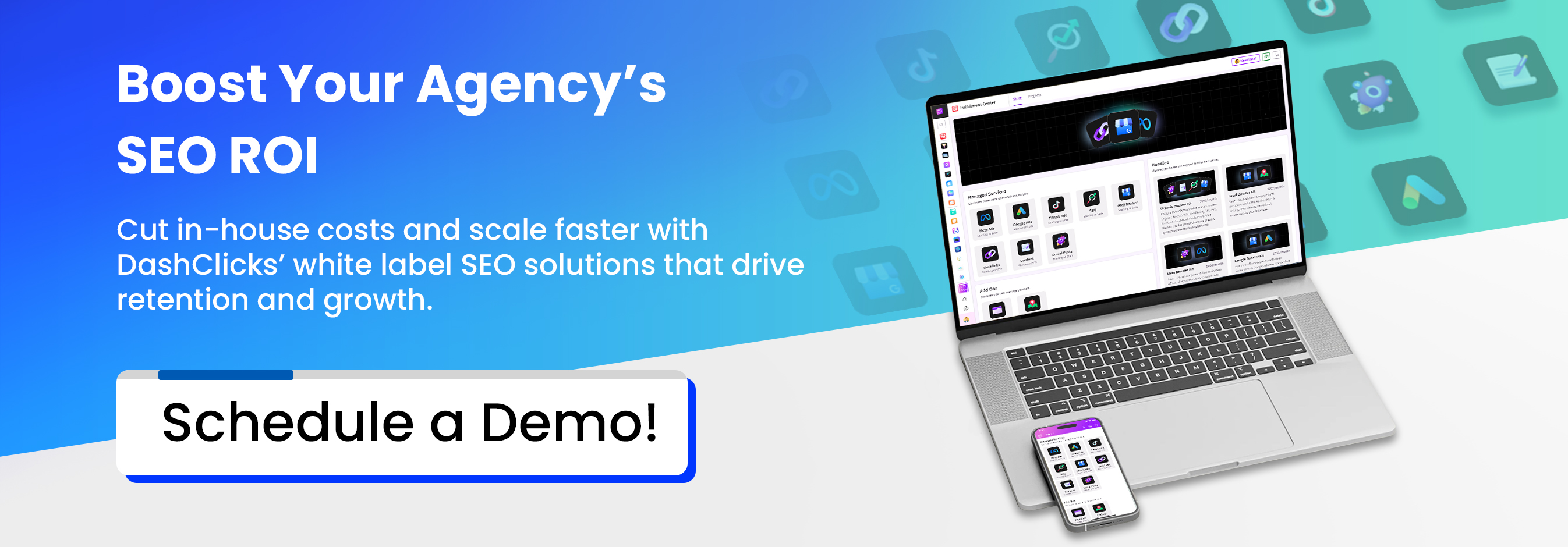

How Conversion Rate Optimization Transforms Ecommerce Growth in 2025
Ecommerce in 2025 is no longer just about attracting traffic — everyone is chasing visitors. The true winners are those who turn that traffic into paying customers. The battleground has shifted from ad spend to on-site performance, and Conversion Rate Optimization (CRO) has become the key growth driver.
When done strategically — especially with the help of a Conversion Optimization Agency that works data-driven and performance-based — CRO can completely transform an ecommerce store’s trajectory. This guide explores how CRO has evolved in 2025, what strategies are most effective, and why merchants should consider partnering with a CRO agency that guarantees measurable results.
The Ecommerce Climate in 2025: Why CRO Matters More Than Ever?
Ecommerce in 2025 faces challenges that didn’t exist just a few years ago — rising customer expectations, increasing ad costs, and the growing complexity of user behavior. That’s why conversion rate optimization consultants are becoming an essential part of many businesses’ strategies to improve performance and drive growth. Here’s why CRO has become so important:
- Rising Customer Expectations: Shoppers demand seamless, fast, and intuitive experiences. Any friction — from slow loading times to confusing checkouts — immediately costs conversions. A single second of delay or one extra form field can lose sales.
- AI and Personalization Dominate: Artificial Intelligence now powers personalization at scale. Sites dynamically change content, recommendations, and pricing based on individual user behavior and purchase history.
- Omnichannel Journeys: Shoppers move fluidly between mobile, desktop, social media, and marketplaces. CRO now requires consistency and optimization across every touchpoint, not just the main website.
- Voice and AR Shopping: Voice search, AR product previews, and immersive digital experiences are mainstream. Shoppers expect to see how a product looks in real life or get instant voice-based assistance before purchasing.
- Data Privacy and Trust: With increasing data regulations, trust has become a conversion factor. Customers buy from brands that are transparent about data usage, returns, and pricing. CRO in 2025 is as much about trust optimization as it is about button color or layout.
- Efficiency Over Acquisition: Ads are more expensive than ever. Improving conversion rates delivers higher ROI than simply buying more traffic. CRO lets brands make every click count.
Together, these trends mean that CRO is no longer optional — it’s the foundation for sustainable ecommerce growth.
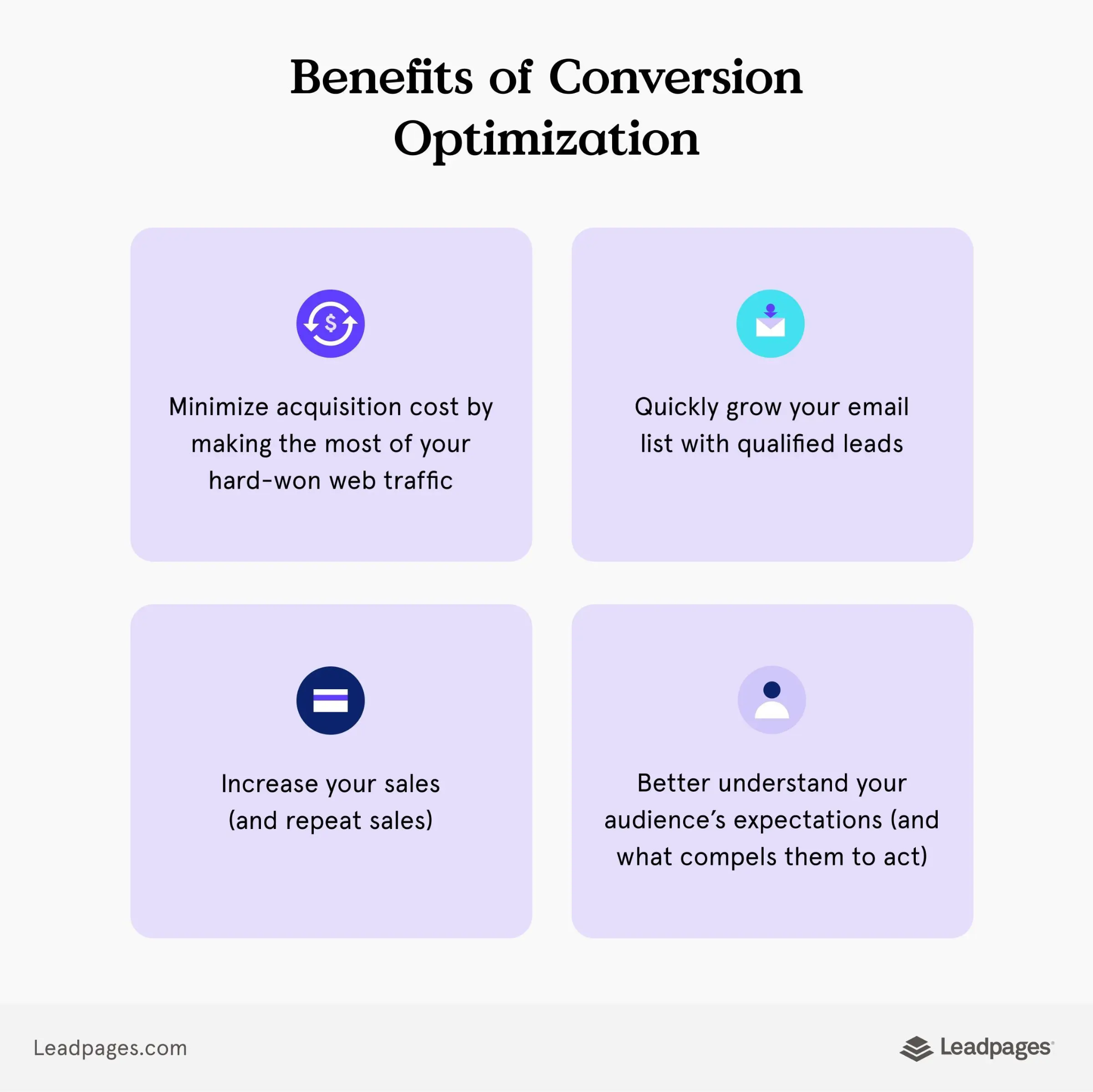
Image Source: Leadpages
Key CRO Strategies and Tactics for 2025
Conversion Rate Optimization in 2025 goes beyond basic A/B tests or minor design tweaks. It’s about understanding your customers deeply and using data-driven experimentation to create frictionless, personalized journeys. Here are the essential strategies reshaping ecommerce performance this year:
- Hyper-Personalization with AI: Ecommerce stores are now leveraging machine learning to create tailored shopping experiences. Product recommendations, homepage banners, and even pricing adjust dynamically based on user intent, browsing behavior, and past purchases. This hyper-personalization keeps shoppers engaged longer and increases purchase likelihood.
- Mobile-First Experience: With mobile traffic dominating ecommerce, optimizing for mobile usability is non-negotiable. That means faster loading times, larger buttons for thumb-friendly navigation, simplified layouts, and checkout flows designed specifically for smaller screens. In 2025, a store that isn’t mobile-first is essentially invisible.
- Streamlined Checkout Flows: One of the biggest reasons for lost sales is cart abandonment caused by complex checkout processes. Winning stores simplify checkout to just a few clicks, offer guest checkout, and clearly display shipping costs upfront. The best CRO teams treat every additional form field as potential friction to remove.
- Behavioral Analytics and User Journey Insights: Instead of relying solely on assumptions, leading ecommerce brands use heatmaps, click tracking, and session recordings to identify real-world friction points. Data reveals where users hesitate, scroll less, or drop off — offering insights that traditional analytics can’t capture. Using tools like DashClicks’ white label analytics platform, ecommerce stores can visualize heatmaps, track clicks, and identify user drop-offs across pages. This data-backed view of user behavior helps CRO teams uncover friction points and prioritize fixes faster.
- Continuous Experimentation and A/B Testing: CRO is no longer a one-time project. Brands now continuously test everything — from headlines and CTAs to product image arrangements and color schemes. Structured testing ensures that every design change is backed by evidence, not opinion.
- Conversational UX and Voice Optimization: Voice search optimization and conversational interfaces are reshaping how users find and buy products. Ecommerce stores are optimizing product pages for natural-language queries and integrating chat assistants to guide shoppers through decisions in real time.
- Trust and Transparency Elements: Modern consumers buy from brands they trust. Adding customer reviews, verified ratings, clear return policies, and visible security badges builds credibility. CRO in 2025 includes “trust signals” as a conversion component.
- Storytelling and Content-Driven Commerce: Content is no longer separate from conversion. High-quality data-driven storytelling, product education, and lifestyle content help customers emotionally connect with the brand. Micro-content like short videos and testimonials bridge the gap between awareness and purchase.
- Omnichannel Consistency: Users expect the same experience whether they engage via Instagram, an app, or the desktop site. Consistent design, tone, and offers across all touchpoints create familiarity — and familiarity boosts conversion.
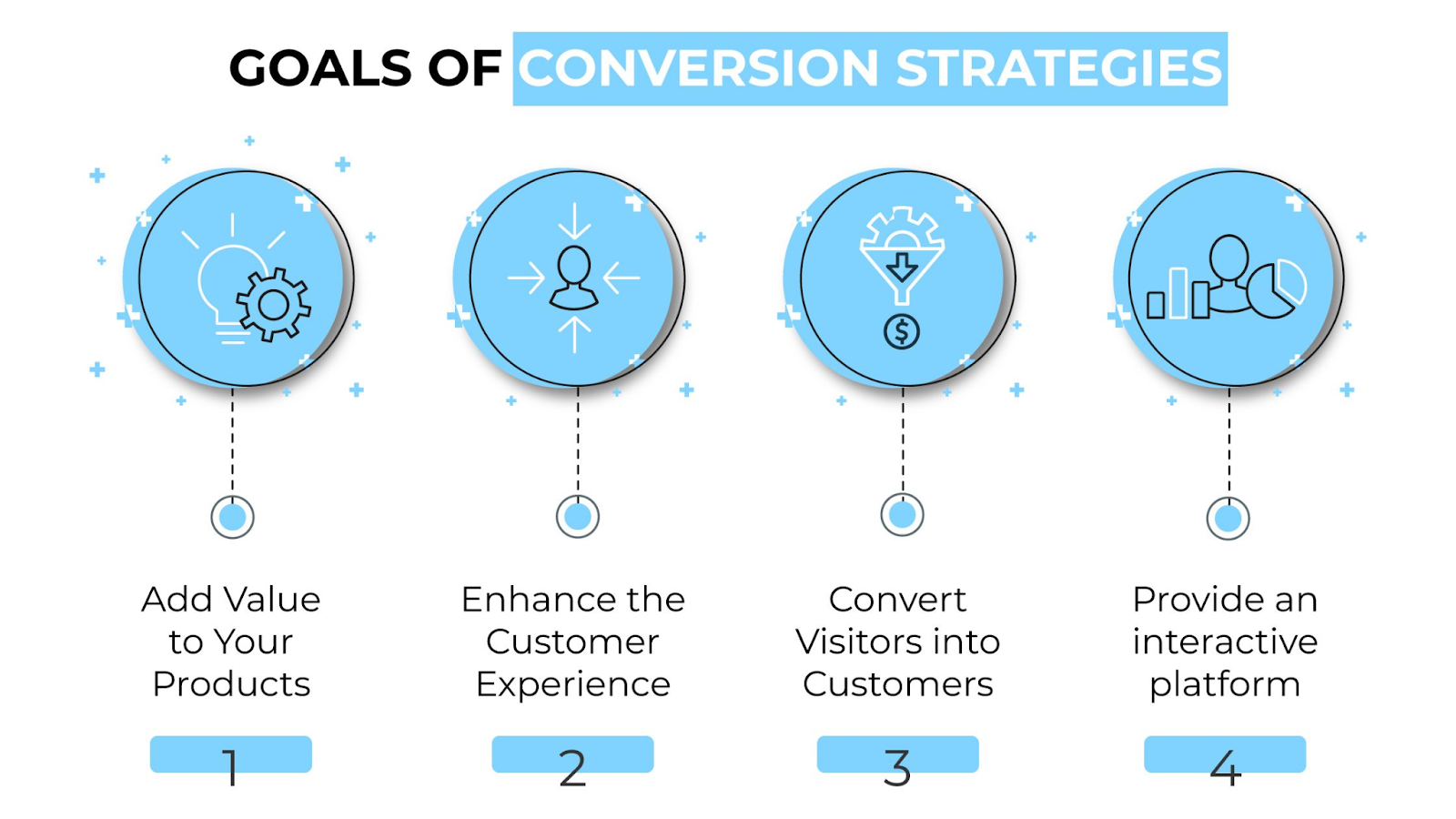
Even modest improvements in these areas can yield outsized results. A 10% increase in conversion rate can translate into thousands or even millions in additional annual revenue, without a single extra visitor.
How a CRO Agency Revolutionizes Ecommerce Store Performance?
While in-house teams can run occasional tests, specialized CRO agencies take optimization to a higher level — using advanced data systems, proven processes, and performance-based guarantees that align directly with business outcomes.
Why Partner with a CRO Agency?
- Deep Expertise: CRO agencies specialize in behavioral design, UX, and analytics. Their teams know how to uncover conversion bottlenecks and apply best practices proven across industries.
- Data Infrastructure and Tools: From advanced analytics dashboards to AI testing platforms, agencies bring technology that’s often too expensive or complex for in-house use.
- Unbiased Experimentation: Agencies analyze your store without internal bias. This objectivity allows them to challenge assumptions and find hidden opportunities.
- Performance-Based Accountability: The best agencies tie their compensation to measurable improvements in conversions or revenue. This ensures complete alignment — you only win when they do.
- Faster Results: With pre-built processes, testing frameworks, and experience, agencies deliver results faster and with higher accuracy than teams starting from scratch.
- Scalable Success: Agencies that have optimized hundreds of ecommerce stores know what strategies scale effectively — giving your business a competitive advantage from day one.
How a Data-Driven CRO Agency Works?
A world-class CRO agency doesn’t just tweak your website — it transforms your digital growth engine through a structured, evidence-based process:
- Comprehensive CRO Audit: The agency begins by analyzing your entire funnel — homepage, category pages, product pages, cart, and checkout. They identify where users drop off, which elements underperform, and where the biggest ROI opportunities lie.
- Data Prioritization: Instead of fixing everything at once, agencies focus on high-impact issues. For example, optimizing checkout friction might yield far greater returns than redesigning the homepage. Prioritization ensures every experiment drives meaningful outcomes.
- Hypothesis and Testing: Every change begins with a hypothesis: “If we simplify the checkout process, completion rate will increase by 20%.” This scientific approach replaces guesswork with controlled testing, ensuring every improvement is validated with data.
- Continuous Optimization: CRO is iterative. As new data emerges, the agency refines hypotheses, runs fresh tests, and builds a knowledge base of what works. This creates a compounding effect — every test builds on previous success. To manage ongoing tests, iterations, and design improvements, CRO teams often rely on project management platforms like DashClicks’ projects management software. It helps streamline collaboration between marketers, designers, and analysts, ensuring every experiment moves from hypothesis to execution efficiently.
- Personalization and Predictive Optimization: Leading agencies now leverage AI to personalize experiences in real time. By analyzing user behavior patterns, they predict which products, layouts, or messages will convert best for each visitor segment. With integrated CRM systems such as DashClicks’ white label CRM software, ecommerce brands can segment audiences more intelligently — feeding personalized offers, emails, and product recommendations that boost conversion rates.
- Transparent Reporting: Performance-based CRO agencies share real-time dashboards showing uplift percentages, A/B test outcomes, and revenue impact. You know exactly how much value each optimization delivers. Tools such as DashClicks’ InstaReports Software make performance reporting effortless. Agencies can automatically generate white-labeled reports showing uplift percentages, test results, and ROI — keeping clients informed with real-time insights.
Example of CRO Transformation in Action
Imagine an ecommerce brand with 100,000 monthly visitors, a 2.5% conversion rate, and an average order value of $50. Here’s how a six-month CRO engagement could transform its growth:
Month 1: The agency audits analytics, heatmaps, and checkout flows. They find that mobile users abandon at the payment stage and that shipping costs appear too late in the process.
Month 2–3: They redesign the checkout to reduce it from five steps to two, add guest checkout, and make shipping costs visible upfront. Conversion improves from 2.5% to 3.2%.
Month 4–6: The agency introduces personalized recommendations, improves search filters, and adds dynamic offers for returning customers. Conversion rises to 4.0%, and average order value grows to $60.
With the same traffic, revenue climbs from $125,000/month to $240,000/month — an increase of over 90% purely through CRO.

Image Source: LandingRabbit
What to Look for When Choosing a CRO Agency?
Since not all agencies are equal, choosing the right partner is crucial. Look for:
- Proven Track Record: Case studies showing real conversion uplifts and measurable ROI.
- Performance Guarantees: Agencies that offer pay-for-results models show confidence in their process.
- Data and Analytical Rigor: Proper tracking setup, audience segmentation, and statistically valid testing.
- Technical and UX Expertise: CRO requires developers and designers who understand user behavior and site performance.
- Tailored Approach: Avoid one-size-fits-all strategies. Every ecommerce store has unique needs.
- Transparent Reporting: Expect regular reports detailing what was tested, why, and what the outcome was.
- Continuous Partnership: CRO isn’t a one-time fix — it’s an ongoing growth engine. Choose an agency committed to long-term optimization.
The Business Impact of Effective CRO
Partnering with a high-performance, data-driven CRO agency can transform ecommerce profitability in measurable ways:
- 20–100% Conversion Rate Increases: Depending on the starting point, stores often see double-digit to triple-digit percentage uplifts.
- Higher Average Order Value: Through strategic upsells, cross-sells, and better product recommendations.
- Lower Customer Acquisition Cost: Better conversion means more revenue from the same traffic, lowering your cost per sale.
- Reduced Cart Abandonment: Simpler checkouts and clear costs keep more buyers engaged to completion.
- Improved Customer Lifetime Value: Enhanced user experience and personalized engagement increase repeat purchases.
- Better Margins and Profitability: CRO-driven growth doesn’t require more ad spend — it multiplies the efficiency of your existing traffic.
Even a seemingly small change — say a 1% increase in conversion rate — can lead to massive revenue growth when scaled across thousands of monthly visitors.
Challenges and How a CRO Agency Solves Them?
While CRO offers huge potential, it comes with pitfalls if done without expertise. A good agency helps avoid them:
- Avoids Random Testing: Every experiment is data-backed, not guesswork.
- Prevents False Positives: Tests run until statistically significant, ensuring reliable conclusions.
- Balances Design and Performance: Aesthetic changes don’t come at the cost of site speed or UX.
- Protects Brand Consistency: Agencies test intelligently without disrupting the user experience.
- Localizes and Segments: Optimizations are tailored to device type, region, and customer segment.
Why Performance-Based CRO Changes the Game?
Traditional agencies often charge flat fees regardless of results. But performance-based CRO agencies change that dynamic. They tie success metrics — like conversion increases or revenue growth — directly to their compensation.
This Creates:
- Shared Risk: You only pay when measurable results are achieved.
- Clear Accountability: Both parties track performance transparently.
- Outcome-Driven Focus: Every action is tied to business impact, not vanity metrics.
- Long-Term Partnership: The agency remains motivated to sustain and improve results continuously.
When incentives align, the partnership becomes mutually profitable — and results speak for themselves.
Getting Started: A Merchant’s CRO Roadmap
If you’re an ecommerce merchant ready to take CRO seriously, follow this roadmap:
- Assess Current Performance: Know your conversion rates, average order value, and biggest funnel drop-offs.
- Set Specific Goals: For example — “Increase checkout completion by 40% in six months” or “Reduce cart abandonment to under 50%.”
- Choose the Right Partner: Evaluate CRO agencies based on case studies, guarantees, transparency, and expertise.
- Prioritize High-Impact Fixes: Start with checkout flow, mobile experience, and top-traffic pages.
- Implement Data Tracking: Ensure you have solid analytics — without accurate data, CRO is impossible.
- Test, Measure, Repeat: Adopt a mindset of ongoing experimentation. The more you test, the faster you learn and grow.
- Scale What Works: Once you find winning variations, roll them out widely and keep iterating.
Conclusion
In 2025, Conversion Rate Optimization isn’t a luxury — it’s the backbone of ecommerce growth. The most successful stores are those that master the post-click experience, turning traffic into tangible profit.
CRO is not about guesswork or aesthetics; it’s about data, experimentation, and measurable improvement. And when you partner with a Conversion Optimization Agency that operates on a performance-based model, you gain more than just expertise — you gain accountability, transparency, and guaranteed results.
In a world where customer acquisition costs keep rising, conversion optimization is the most reliable way to grow sustainably. Whether you’re a small merchant or an established ecommerce brand, investing in CRO today means thriving tomorrow.


Micro vs. Macro: Choosing the Right Content Creators for Your Marketing Goals
The current digital landscape considers content creators more than just marketers’ partners. No, they are trusted voices and community leaders who set cultural trends.
Audiences are paying more attention to influencers, TikTokers, YouTubers, Twitch streamers, and niche authors to seek recommendations for what to buy or where to travel. It shouldn’t come as a surprise that studies indicate that traditional marketing methods bring less ROI than influencer marketing.
Having said all that, brands still have to figure out which content creator they should go with. And the decision often comes down to choosing between micro and macro influencers. One size fits all isn’t a possibility given how many different brands and content creators are out there. Each has its idiosyncrasies.
Let’s unpack the differences between micro and macro creators and explore the pros and cons each brings to the table.
Defining Micro and Macro Creators
First things first. It’s necessary to define what makes a content creator micro or macro. Consider the details below.
Micro Creators:
Has a follower range between 1,000 to 100,000. Highly engaged communities and niche expertise (think fitness, vegan recipes, local travel, beauty trends). Content feels authentic and conversational.
Micro-influencers hardly treat themselves as celebrities. If anything, they are seen as relatable peers with credibility in a particular niche. The followers interact actively via comments or direct DMs, which leads to a sense of community.
Macro Creators:
Has a follower range between 100,000 to 1M. Offers a broader reach across different demographics. Known for polished and professional content production. Recognized as a brand and provides higher visibility.
Macro-influencers operate at a large scale, which often involves a team supporting the content creation and other processes.
Nano and Mega Creators:
As a side note, it’s worth mentioning that nano-creators (less than 1,000 followers) and mega creators (1 million+ followers) exist as well. However, for most brands, the sweet spot is usually somewhere between a micro and a macro influencer rather than a very niche creator or a super celebrity.
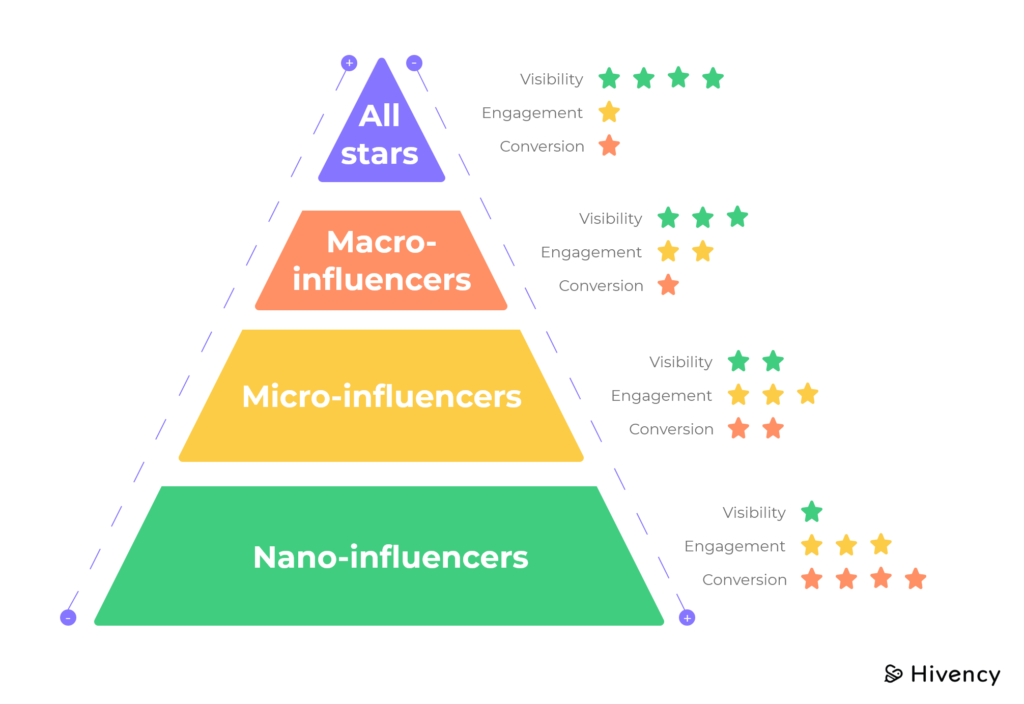
Image Source: Skeepers
Advantages of Micro Creators
- Engagement and Authenticity: Micro creators enjoy higher engagement rates compared to macro creators. The audience sees a micro creator as an authentic voice, not an advertiser.
- Trust and Relatability: Micro creators focus on building a community around shared values or lifestyles. Followers feel a personal connection with someone they can relate to.
- Flexibility: They don’t have to deal with rigid management structures, so it’s easier to adapt campaign messages to suit the creator's style. This, in turn, leads to more natural and genuine content.
- Cost Effectiveness: Micro creators usually charge lower fees. Small and medium businesses have an easier time finding a creator to work with. And it’s common to collaborate with multiple micro-creators who are cheaper, to diversify reach.
Advantages of Macro Creators
- Large Reach: Macro creators expose brands to hundreds of thousands of people. In case of awareness campaigns or major product launches, such reach could make all the difference.
- Scalability: If a business wishes to scale quickly and do so in multiple regions or demographics, macro creators are far superior to their micro counterparts.
- Content Quality: Macro creators tend to invest more in content quality. The higher the content quality, the easier it is for brands to remain consistent with their brand identity.
- Stronger Brand Association: Brand perception reaches new heights when a business partners up with a well-known creator. The collaboration signals credibility, authority, and alignment with the current mainstream culture and trends.
Drawbacks to Consider
Micro Creators:
- Management Challenges: If a business opts to run with multiple micro creators, managing all the campaigns can require a lot of resources.
- Quality Concerns: Content quality varies since not all micro-creators have the tools or knowledge to produce good quality.
- Limited Reach: A single micro creator won’t deliver mass visibility. This might lead to working with multiple creators simultaneously, which, as stated before, complicates coordination.
Macro Creators:
- Reduced Authenticity: Some audiences may see a collaboration with a macro influencer as commercial, which diminishes trust.
- Engagement Rate: With the rise of follower count, engagement rate tends to decline over time. Macro influencers are less relatable.
- Costs: Fees for working with a macro creator could be significant and not affordable for some enterprises.
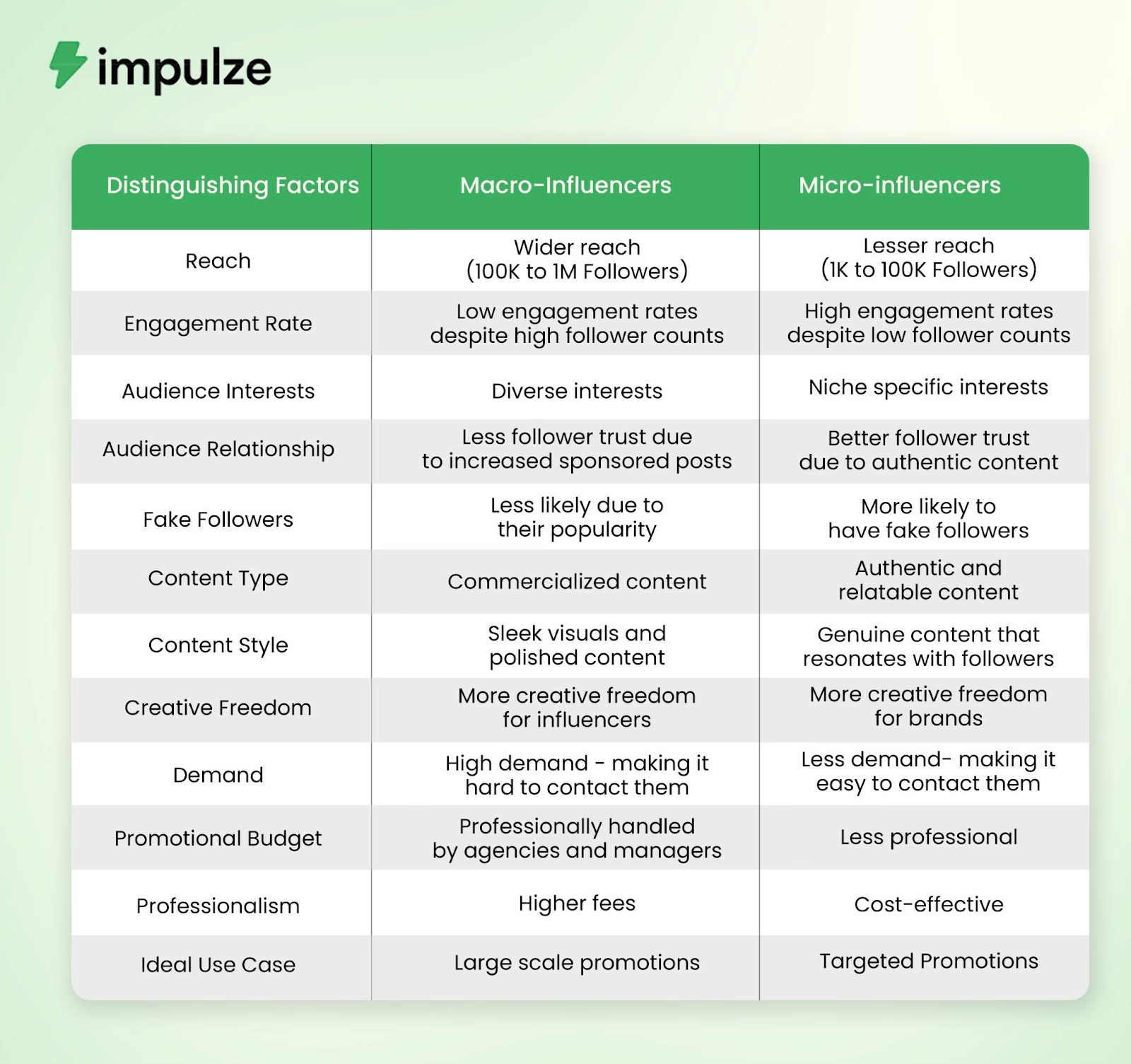
Image Source: Impulze
Matching Creators to Marketing Goals
Choosing between the two isn’t about one being better than the other. Businesses need to align the options with objectives. And once the plan is in place, they can focus on finding the most suitable content creator.
- Product Launch: When launching a new product, a hybrid approach is often the go-to. Macro creators give massive reach and visibility. Meanwhile, micro influencers build credibility and word of mouth within their niche audiences.
- Brand Awareness Campaigns: If the ultimate goal is to raise brand awareness and reach as many prospects as possible, macro creators are the most suitable option. The larger the audience, the broader the reach brands can expect.
- Engagement and Community: Micro-creators excel in encouraging UGC (user-generated content) or fostering loyalty. They are more intimate with their audiences, so it’s much easier to appear genuine and persuade followers to believe in an advertised brand.
Real-Life Example:
A relatively small TikTok content creator who works in a beauty product niche and pays close attention to the platform's viral trends and challenges is given the task of promoting a new face cream.
They opt for storytelling in a bathroom, face-to-camera, and weave the product into the narrative rather than the headline. The intimacy from a prospect's point of view feels like a one-on-one chat, and lands the recommendation as genuine.
How to Choose the Best Fit?
Choosing between macro and micro content creators takes more than one expects. However, the search becomes easier if you follow some basic principles.
- Define the Campaign Goals: Businesses should start by defining their campaign goals. They have to be explicit about seeking awareness, engagement, customers, or loyalty. The clearer the goal, the easier it is to choose the right creator.
- Analyze Audience Overlap: Don’t look at just the follower count. Pay attention to the creator’s audience and whether it aligns with the target audience. Also, double-check to confirm that the values and lifestyle are relevant.
- Evaluate Engagement: Check the metrics to determine how genuine the creator’s audience is. Look at likes, comments, shares, saves, and other available metrics.
- Consider Long-Term Collaborations: Ongoing collaborations tend to build stronger associations compared to one-off campaigns. If possible, find creators who are up for a long-term partnership.
- Test and Scale: Don’t overinvest in a particular partnership. Instead, start small and see how things are going. If the collaboration is smooth and valuable, scale it from there. And if not, seek alternatives and learn from what went wrong to adjust to the next campaign.
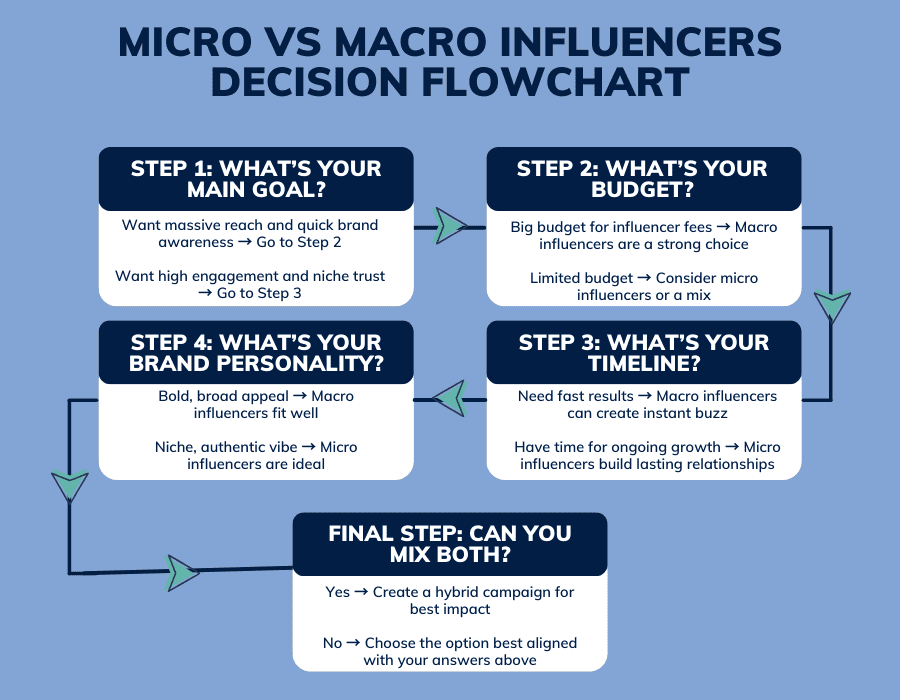
Image Source: Afluencer
Agency Perspective: Why It Matters?
For digital marketing agencies, the choice between micro and macro creators isn’t just about reach versus engagement — it’s about aligning the right influencer strategy with each client’s goals and budget. Agencies often juggle multiple clients across industries, each with unique expectations. That means one-size-fits-all influencer strategies rarely work.
1. Managing Multiple Clients with Different Goals: A local café might need five micro-influencers to build strong community buzz, while a national e-commerce brand may prefer one macro creator for mass visibility. Agencies must balance these needs while ensuring campaigns remain cost-effective, measurable, and scalable.
2. Offering Influencer Marketing as a White-Label Service: Not every agency has an in-house influencer team. By offering influencer marketing through white label content services, agencies can instantly expand their offerings without hiring new staff. This lets them provide influencer strategy, outreach, and content management under their own brand name — keeping clients happy while saving time and resources.
3. Packaging Influencer Partnerships into Service Bundles
Agencies can package micro and macro influencer collaborations into broader marketing bundles. For example:
- Brand Awareness Bundle → SEO + paid ads + macro influencer campaigns
- Community Growth Bundle → Social media management + micro influencer partnerships
- Product Launch Bundle → Hybrid campaigns with both micro and macro creators
By productizing influencer services in this way, agencies can sell repeatable solutions, improve client retention, and stand out from competitors.
In short, agencies that understand how to balance micro and macro creators not only deliver better results for clients but also strengthen their own business model.
DashClicks’ White Label Social Media Management Services
Managing multiple social media campaigns for clients can be time-consuming and resource-intensive for agencies. DashClicks’ White Label Social Media Management Services empower agencies to deliver high-quality, results-driven social media campaigns under their own brand — without the overhead of an in-house team.
Whether your clients need consistent posting, audience engagement, influencer collaborations, or performance reporting, our services cover it all. From strategy to execution, we make it easy for agencies to scale social media offerings across multiple clients.
- End-to-End Social Media Management – Content creation, scheduling, posting, and engagement across platforms like Instagram, TikTok, Facebook, LinkedIn, and more.
- Influencer Integration – Leverage micro and macro creators in your campaigns to maximize engagement and reach.
- Analytics & Reporting – Track campaign performance, engagement, and growth with professional, branded reports.
- Scalable Solutions – Manage campaigns for one client or dozens, all under your agency’s name.
- Flexible Collaboration – Tailor services to client goals, whether it’s awareness, engagement, lead generation, or community building.
With DashClicks, agencies can offer full-service social media management that drives results, strengthens client relationships, and scales without adding internal staff. Deliver campaigns that engage, convert, and build lasting brand authority — all under your own agency’s brand.
Conclusion
Ultimately, choosing between micro and macro content creators comes down to strategic alignment. Both options have their ups and downs, so focusing on which one is inherently better shouldn’t be the approach.
Micro creators excel in authenticity and cost effectiveness, while macro creators deliver reach and authority.
The most effective campaigns blend the two options, but the full power behind creator partnerships is unlocked once businesses clarify their goals and carefully analyze the targeted audiences.


The Future of White Label SEO: Integrating AI and Machine Learning
The SEO landscape changes faster than most agencies can keep up. Search algorithms evolve, user behavior shifts, and new competitors emerge daily. What worked last quarter might be outdated next month. This rapid evolution creates immense pressure for marketing agencies trying to deliver consistent results for multiple clients.
Traditional, manual SEO approaches are becoming a burden rather than an asset. Hours spent on keyword research, content optimization, and performance reporting leave little time for strategic thinking. When you're managing dozens of clients, the manual approach simply doesn't scale.
Enter artificial intelligence and machine learning. These technologies aren't just buzzwords—they represent a fundamental shift in how SEO services can be delivered. AI-powered tools can process massive datasets, identify patterns humans miss, and execute repetitive tasks with precision and speed. For agencies looking to outsource SEO services effectively, AI integration has become essential.
This post explores how AI is revolutionizing white label SEO services. We'll examine how automation streamlines tedious tasks, machine learning provides predictive insights, and intelligent tools help agencies deliver superior results while scaling their operations. We'll also address common concerns about AI adoption and show you what the future holds for SEO agencies ready to embrace this transformation.
The Old Guard: Limitations of Manual White Label SEO
Why Traditional SEO Is Holding Your Agency Back
Manual SEO processes are consuming resources that could be better spent elsewhere. Consider the hours your team spends on keyword research, sifting through endless spreadsheets to find opportunities. Then there's link-building outreach—crafting personalized emails, tracking responses, and managing follow-ups. Performance reporting alone can take days each month per client.
These time-consuming tasks eat into billable hours that could be focused on high-level strategy and client relationship building. When every process requires manual intervention, growth becomes exponentially more difficult.
- Scalability becomes the biggest challenge. Adding new clients means adding proportional workload. More keyword tracking, more content reviews, more technical audits. Without significant investment in additional staff, agencies hit a ceiling. According to recent industry research, 37% of agencies identified acquiring new clients as their primary obstacle, surpassing other concerns such as time constraints and cash flow by a significant margin.
- Data overload creates missed opportunities. Modern SEO involves analyzing massive amounts of information—search volumes, competitor strategies, technical performance metrics, and user behavior data. Human analysts can only process so much before patterns get missed. Those subtle correlations that could unlock significant client growth often remain hidden in the data.
- Keeping pace with algorithm changes proves nearly impossible. Google makes thousands of algorithm updates annually. Manual processes can't adapt quickly enough to these changes. By the time agencies identify what's working differently, competitors using automated tools have already adjusted their strategies.
- Inconsistent results plague manual efforts. Human error, bias, and fatigue impact quality. One team member might interpret data differently from another. Client strategies become inconsistent, leading to varied outcomes that are difficult to explain or replicate.
These limitations point to a clear need for automation. Agencies that continue relying solely on manual processes will find themselves overwhelmed by workload while struggling to deliver consistent, scalable results.
The Shift from Manual SEO to AI-Augmented SEO
White label SEO started with basic services—monthly reports, link building campaigns, and technical audits. Agencies needed external partners to handle overflow work or specialized tasks. This model worked when SEO was simpler and search engines were more predictable.
AI has transformed this landscape completely. Modern SEO requires processing enormous datasets, understanding user intent at scale, and adapting strategies in real-time. These tasks are perfect for artificial intelligence.
AI automates the repetitive work. Keyword tracking, technical audits, and backlink analysis can now run continuously in the background. This automation frees human experts to focus on strategy, client communication, and creative problem-solving.
Machine learning algorithms excel at pattern recognition. They can analyze user behavior across thousands of websites to predict which content will perform best. They identify technical issues before they impact rankings. They spot opportunities in competitor strategies that human analysts might overlook.
As one industry expert noted, "Use machine learning to predict user behavior and search trends to alter your SEO approach in real time." This real-time adaptation gives AI-powered agencies a significant competitive advantage.
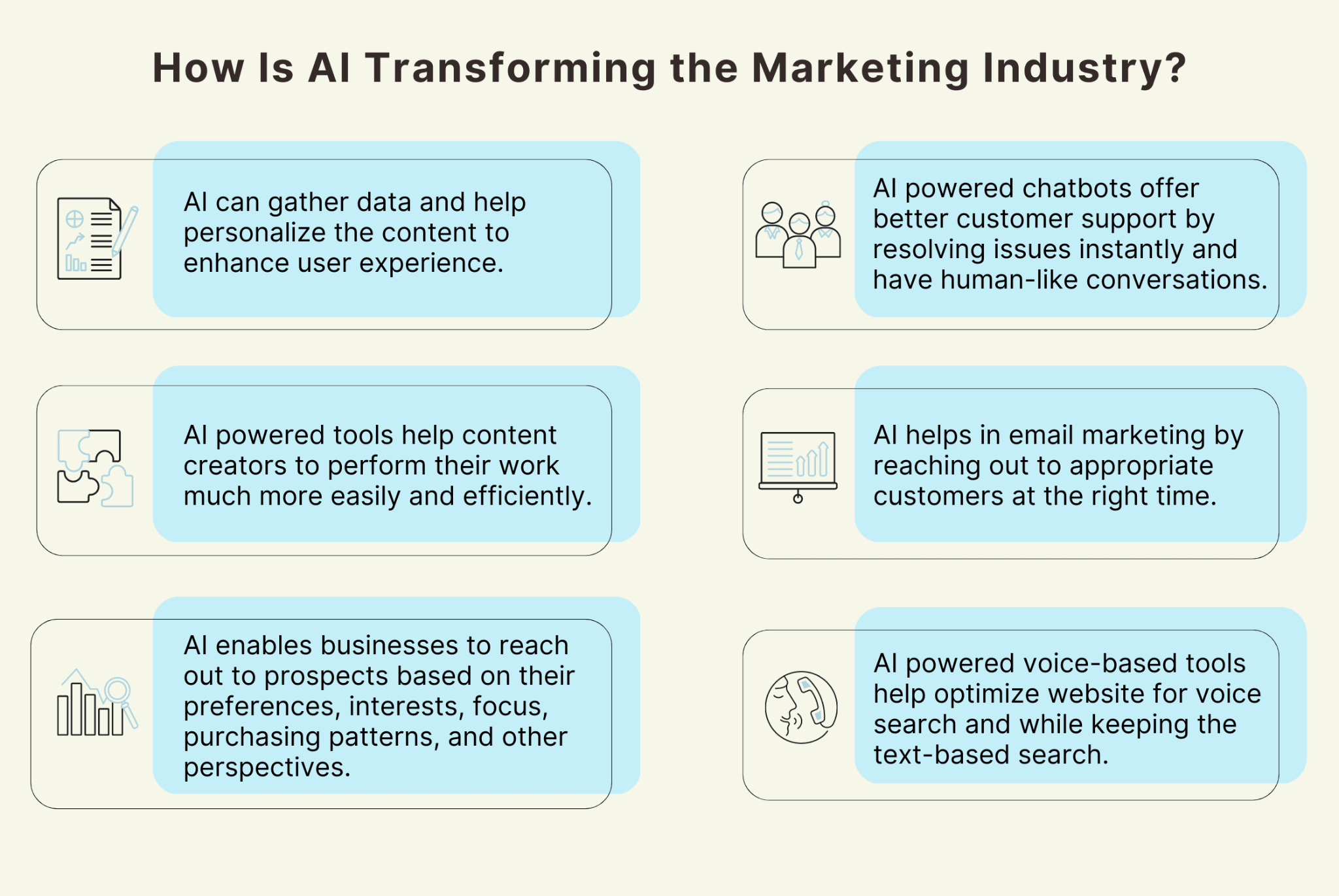
The shift isn't about replacing human expertise—it's about amplifying it. AI handles data processing and routine tasks, while humans provide strategic direction, creative insights, and client relationship management.
The AI Revolution: How AI is Redefining SEO Operations
1. AI-Enhanced Keyword Research
Gone are the days of static keyword lists and manual search volume analysis. AI-powered keyword research utilizes natural language processing to comprehend searcher intent at an unprecedented level. These tools analyze semantic relationships, identifying keyword clusters that capture the full spectrum of user queries.
Modern AI systems can predict keyword trends before they peak. They analyze search patterns, social media conversations, and content performance to forecast which terms will become valuable. For seasonal campaigns, this predictive capability provides months of planning opportunity.
Conversational AI models like ChatGPT have revealed the importance of long-tail, question-based queries. AI tools can generate hundreds of these conversational keywords that traditional research methods would miss entirely.
2. Intelligent Content Optimization
AI transforms content creation from guesswork into a data-driven strategy. Machine learning algorithms analyze top-performing content across industries to identify patterns in structure, tone, and keyword usage.
Content scoring tools powered by AI can evaluate drafts against hundreds of ranking factors simultaneously. They check readability scores, keyword density, semantic relevance, and E-E-A-T (Experience, Expertise, Authoritativeness, Trustworthiness) signals.
For agencies managing content across multiple clients, AI ensures consistency. As one expert explains, "Generative AI ensures tone consistency and keyword alignment across content." This consistency becomes crucial when different team members work on the same client account. To explore how AI can be implemented for such tasks, visit www.addepto.com.
AI can generate content briefs that include specific instructions for freelance writers. The review process becomes streamlined when content already meets optimization standards before human review.
3. Automated Technical Audits
Technical SEO audits that once took days can now be completed in minutes. AI-powered crawling tools automatically detect duplicate title tags, broken links, missing schema markup, and page speed issues across entire websites.
Machine learning models excel at anomaly detection. They can spot unusual traffic drops, indexing problems, or ranking fluctuations immediately. This early warning system helps agencies address issues before they significantly impact client performance.
Real-time monitoring has become possible with AI automation. Instead of monthly audits, agencies can provide continuous technical oversight. As industry research shows, "Real-time audits are reshaping how agencies deliver ongoing technical SEO monitoring."
4. Personalization and User Experience Optimization
AI enables personalization at scale for local SEO and user experience optimization. Machine learning algorithms can dynamically adjust business descriptions, optimize NAP (Name, Address, Phone) consistency across directories, and personalize content based on location and user behavior.
For multi-location businesses, AI can create unique, optimized content for each location while maintaining brand consistency. This localization was previously too resource-intensive for most agencies to offer.
Predictive analytics help agencies understand user behavior patterns. AI can forecast click-through rate for different titles and meta descriptions variations, allowing agencies to test and optimize before implementing changes.
5. Data-Driven Decision Making
Predictive Analytics represents perhaps the most powerful AI application in SEO. Machine learning models can forecast traffic growth, predict the impact of ranking improvements on conversions, and model different strategic scenarios.
These predictions help agencies set realistic client expectations and demonstrate potential ROI before implementing strategies. When presenting to clients, agencies can show projected outcomes based on historical data patterns.
Advanced Competitor Analysis uses AI to monitor competitor strategies continuously. Machine learning algorithms track competitor content publication schedules, identify their top-performing pages, and predict their strategic moves based on pattern analysis.
This intelligence helps agencies identify gaps in competitor strategies and opportunities for client growth. Instead of quarterly competitor reviews, agencies can provide real-time competitive insights.
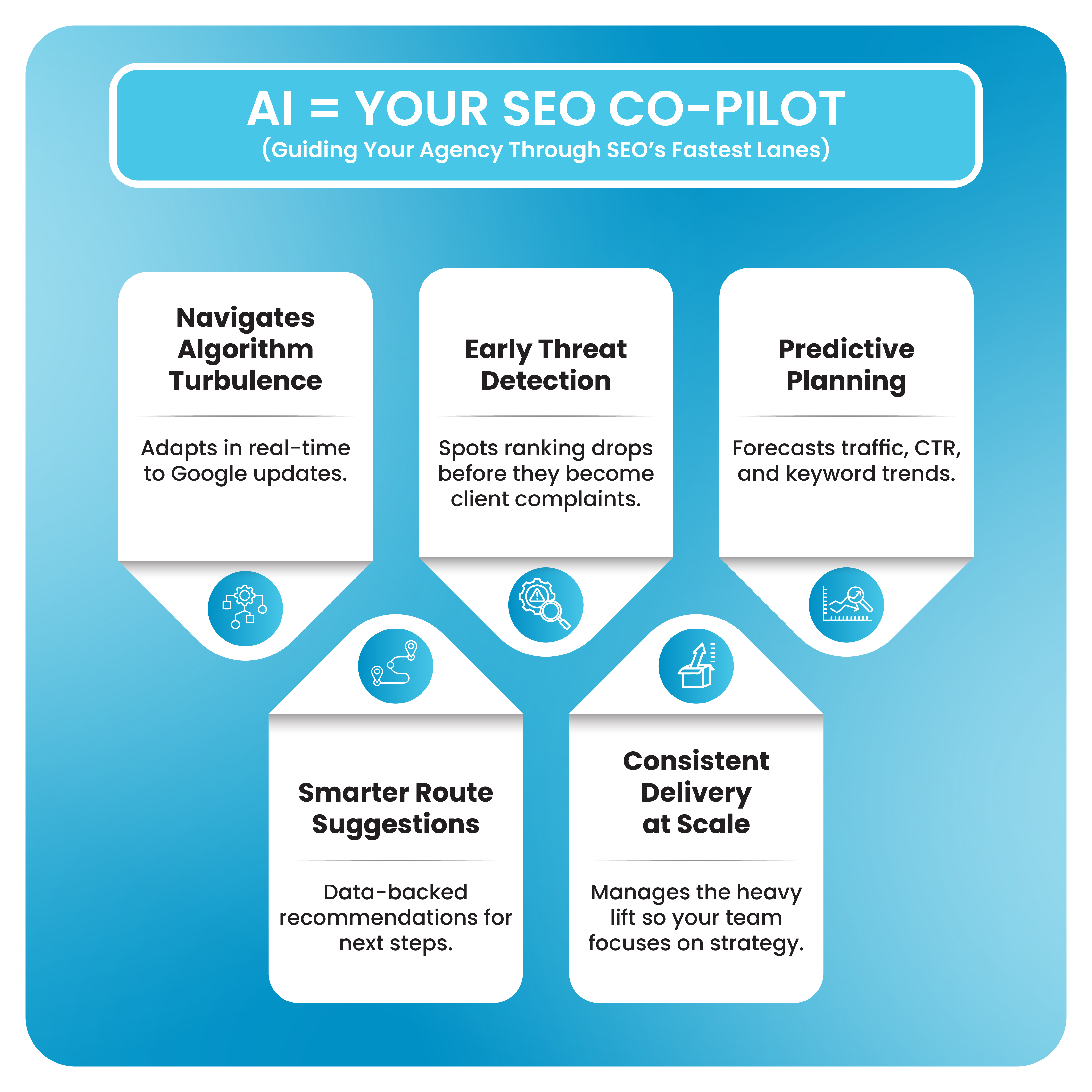
How an AI-Powered White Label SEO Partner Elevates Agencies?
AI-powered SEO partnerships transform agency operations in measurable ways. Agencies can scale client delivery without proportionally increasing headcount. Tasks that previously required weeks can be completed in days or hours.
- Faster turnarounds enable proactive client success. When technical audits are completed automatically and content optimization happens in real-time, agencies can address issues before clients even notice problems. This proactive approach strengthens client relationships and reduces churn.
- AI-backed insights build client trust. When recommendations come with predictive analytics and data-driven forecasts, clients feel more confident in agency expertise. The ability to show projected outcomes and measure results precisely demonstrates value clearly.
- Content consistency across multiple accounts becomes achievable with AI assistance. Brand voice guidelines can be programmed into AI tools, ensuring all content maintains appropriate tone and messaging regardless of which team member creates it.
- Multi-service capabilities expand when AI handles routine tasks. Agencies can offer comprehensive digital marketing bundles including SEO, PPC, social media, and local listing management without overwhelming their teams.
- Future-proofing against SERP changes becomes possible with predictive AI models. As Google introduces AI Overviews and other SERP features, agencies with AI-powered insights can adapt strategies quickly rather than reacting months later.
According to industry statistics, AI automation in SEO reduces manual workload by 55% and AI-powered tools streamline reporting tasks by up to 50%.
Choosing the Right AI-Powered Partner to Outsource SEO Services
What to Look for in a Modern SEO Partner
- Integration capabilities should be your first consideration. The AI tools your partner uses must connect seamlessly with your existing workflow and reporting platforms. Look for partners who can provide API access and custom integrations that fit your specific needs.
- Transparency in methodology becomes crucial when AI is involved. Your partner should clearly explain how their AI tools work, what data they analyze, and how they make recommendations. Avoid providers who treat their AI as a "black box" without explaining their processes.
- Human-AI hybrid models deliver the best results. The most effective partners combine AI's data processing power with human strategic oversight and creativity. Look for providers who emphasize that AI enhances human expertise rather than replacing it.
- Customizable reporting helps you communicate AI-driven strategies to clients effectively. Your partner should translate complex algorithmic insights into understandable business outcomes. Reports should clearly show how AI-powered optimizations impact client success metrics.
Consider partners who demonstrate measurable results from their AI implementations. Ask for case studies showing before-and-after performance metrics from similar client engagements.
Risks, Challenges & Ethical Concerns of AI in White Label SEO
- Over-reliance on automation presents the biggest risk. While AI excels at data processing and pattern recognition, human expertise remains essential for strategic decision-making, creative problem-solving, and client relationship management. Agencies that eliminate human oversight often deliver generic solutions that miss client-specific nuances.
- Content originality concerns arise with generative AI tools. Search engines penalize duplicate or low-quality content, making it crucial to use AI as a writing assistant rather than a replacement for human creativity. Proper fact-checking and originality verification become essential processes.
- Data privacy and transparency issues require careful consideration. AI tools process vast amounts of client data, making data security protocols critical. Agencies must ensure their AI partners comply with privacy regulations and provide clear data handling policies.
- Algorithm bias can perpetuate existing inequalities in search results. AI models trained on biased data may recommend strategies that favor certain demographics or business types. Regular auditing of AI recommendations helps identify and correct these biases.
- Ethical considerations become complex when AI enables sophisticated manipulation of search results. While optimization is acceptable, agencies must balance effectiveness with ethical practices that benefit users, not just rankings.
- Job displacement concerns affect the SEO industry as automation handles more tasks. However, rather than eliminating jobs, AI typically shifts roles toward higher-level strategy and agency-client relationship management.
- Regulatory implications continue evolving as governments develop AI oversight policies. Agencies should stay informed about emerging regulations that might affect AI tool usage in marketing contexts.
Understanding these risks helps agencies implement AI responsibly while maximizing its benefits for client success.
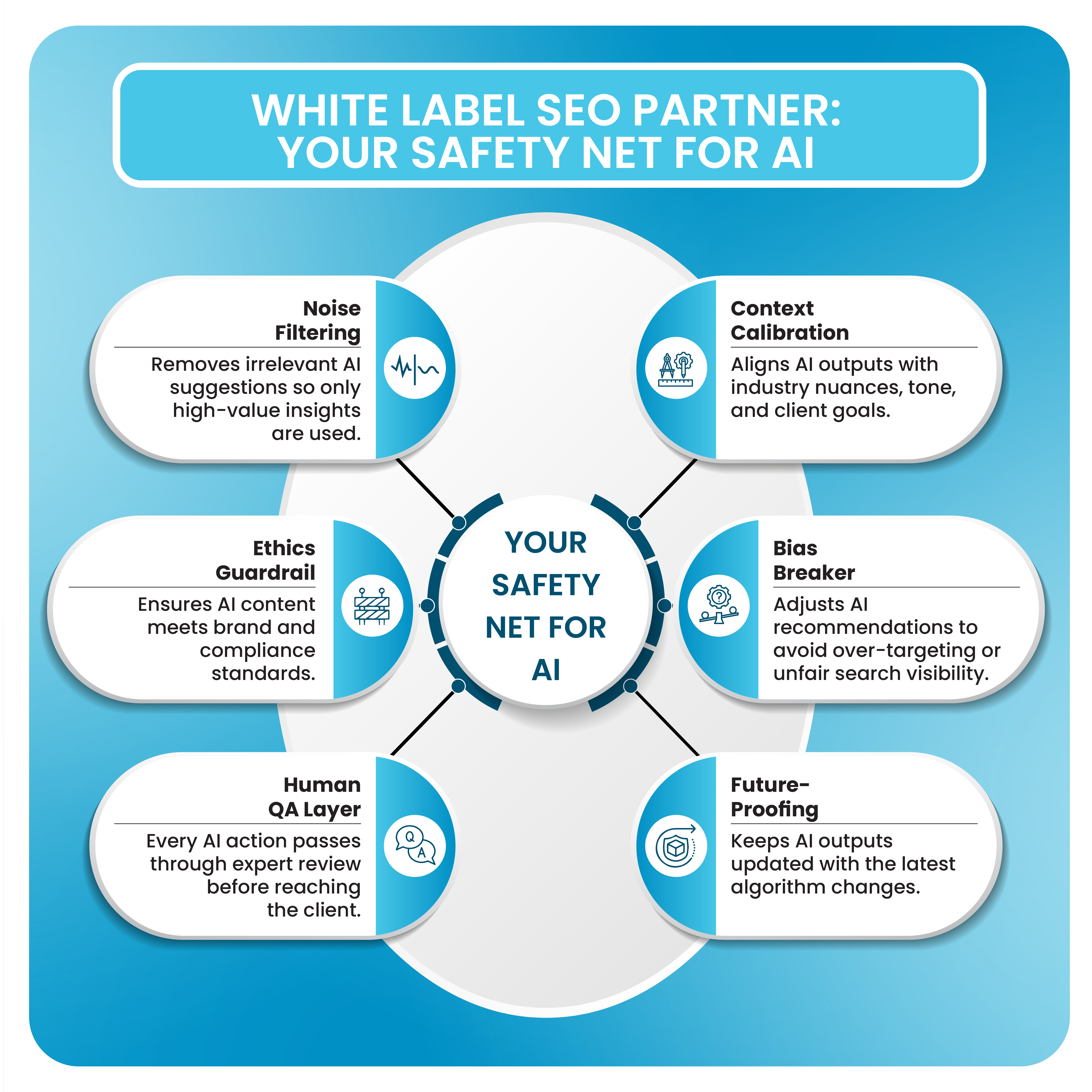
Transforming White Label SEO With DashClicks
DashClicks demonstrates how AI integration transforms white label SEO delivery. Their platform combines advanced AI-powered tools with comprehensive marketing services, rated 4.9/5 stars across over 1,500 verified reviews. This rating reflects their success in helping agencies scale through intelligent automation.
The DashClicks platform integrates AI throughout its SEO process. Their InstaSites tool uses artificial intelligence to build optimized websites in seconds, while their InstaReports feature generates comprehensive SEO audits using automated analysis. These tools enable agencies to deliver services that would traditionally require weeks of manual work.
Their white label SEO services leverage machine learning for keyword research, content optimization, and technical auditing. The AI handles data processing and pattern recognition while human experts provide strategic oversight and quality assurance. This hybrid approach delivers consistent results across thousands of client accounts.
For agencies looking to integrate AI into their SEO offering, DashClicks provides both the technology platform and fulfillment services. Their comprehensive approach includes AI-powered website building, automated reporting, and full white label fulfillment that allows agencies to scale without additional overhead.
The Path Forward for AI-Powered SEO Agencies
The days of relying solely on manual SEO processes are fading fast. While traditional approaches often create bottlenecks in scalability and consistency, AI and machine learning are rewriting the rules—bringing automation, precision, and data-driven insights that elevate both efficiency and results.
For agencies, the message is clear: integrating AI into white label SEO isn’t some distant innovation—it’s the competitive edge agencies need right now. Those who adapt will deliver faster, smarter, and more impactful campaigns, while those who delay risk falling behind in an increasingly AI-driven landscape.
If you’re still bogged down by repetitive manual tasks, now is the time to re-evaluate. Ask yourself: Are we maximizing our efficiency and client results, or is it time to partner with an AI-powered white label SEO provider who can help us scale with confidence?


How to Coordinate Content Briefs & Review Cycles with White Label SEO Partners: The Complete Guide
Managing content creation with white label SEO partners can feel like juggling multiple balls while riding a unicycle. You want high-quality content that matches your brand voice, meets SEO requirements, and gets delivered on time—but coordinating all these moving parts often leads to missed deadlines and countless revisions.
Statistics show that 73% of agencies struggle with content coordination when outsourcing to white label SEO providers. This challenge results in missed deadlines, quality issues, and strained client relationships that can seriously hurt your agency's growth potential.
However, agencies that implement proper coordination systems see remarkable improvements. They can increase their content output by up to 300% while reducing revision cycles by 60%. These numbers aren't just impressive—they represent the difference between agencies that scale successfully and those that remain stuck in operational chaos.
This guide will walk you through proven frameworks for creating effective content briefs, establishing efficient review processes, and implementing robust quality control systems specifically designed for white label SEO partnerships. By the end, you'll have the tools to transform your content coordination from a source of stress into a competitive advantage. Let’s dive in.
Why Content Briefs & Review Cycles Are the Backbone of White Label SEO?
Poor content coordination costs agencies more than just time—it damages relationships and limits growth potential. When briefs lack clarity or review processes break down, the hidden costs pile up quickly.
Sloppy briefs lead to wasted hours spent on revisions, content that misses your brand tone, and SEO opportunities that slip through the cracks. These issues create a ripple effect that impacts every aspect of your agency's operations.
The Unique Challenge of External Partnerships
Working with white label SEO providers introduces coordination challenges that don't exist with in-house teams. Communication happens across different time zones, brand guidelines must be crystal clear, and quality standards need constant reinforcement.
Common Pain Points Include:
- Miscommunication about project requirements and expectations.
- Brand inconsistency across different pieces of content.
- Missed deadlines due to unclear workflows and approval processes.
- Quality control gaps that lead to substandard deliverables.
The cost of inefficient coordination extends beyond immediate project delays. Poor coordination creates client dissatisfaction, increases team stress, and prevents agencies from taking on new business opportunities.
Why Briefs Are Strategic Blueprints, Not Just Templates?
Effective content briefs serve as more than simple instruction sheets. They function as strategic blueprints that guide every aspect of content creation, from keyword research to final publication.
Brandlume Insight: White label workflows thrive when delivery is structured and revision cycles are predictable. Briefs should be seen not as one-off documents, but as strategic blueprints for scalable SEO content.
Understanding the Agency-Provider Workflow
Success starts with clearly defined roles and responsibilities. Everyone involved in the content creation process needs to understand exactly what they're responsible for and when their input is required.
1. Defining Clear Roles
Effective agencies establish distinct roles for content coordination:
- Brief creators who translate client needs into actionable instructions.
- Content executors who produce the actual deliverables.
- Quality reviewers who ensure standards are met before client delivery.
2. Establishing Review Cadences
Regular check-ins prevent small issues from becoming major problems. Successful agencies implement structured review schedules that include:
- Weekly snapshots for ongoing project status updates.
- Monthly deep dives for strategy alignment and performance analysis.
Aligning on workflow ownership prevents bottlenecks and miscommunication. When everyone knows their role and timing, projects move smoothly from brief to final delivery.

Anatomy of a High-Impact SEO Content Brief
A comprehensive content brief serves as the foundation for successful white label SEO partnerships. Each section should provide specific, actionable guidance that eliminates guesswork and ensures consistent results.
1. Target Keywords and Search Intent Analysis
Your keyword section should go beyond simple keyword lists. Provide comprehensive keyword research that includes search volume data, competition analysis, and clear intent mapping for each target term.
Include primary keywords that drive your main SEO objectives, secondary keywords that support topical relevance, and long-tail keywords that target specific user queries. Don't forget to specify keyword density requirements and explain how keywords should be naturally integrated into the content.
Create detailed templates for your keyword briefing sections. This ensures consistency across all projects and makes it easier for providers to understand your requirements.
2. Content Structure and Technical Requirements
Technical specifications eliminate confusion about formatting and SEO elements. Outline your heading hierarchy requirements, specifying how H1, H2, and H3 tags should be structured throughout the content.
Detail your meta description requirements, including character limits and optimization guidelines. Specify internal linking strategies with clear anchor text requirements, and include technical SEO elements like schema markup, image optimization, and URL structure specifications.
3. Brand Voice and Quality Standards
Brand voice guidelines should include specific examples of acceptable and unacceptable language. Create detailed content quality metrics and scoring systems that help providers understand your standards.
Define target audience personas with clear pain point mapping. Include competitor analysis requirements and differentiation strategies that help your content stand out in the market. A well-structured brief sets the foundation for content that is SEO-friendly, on-brand, and client-ready.
Further Reading: Maintaining Client Brand Voice When Outsourcing SEO Services
Building Streamlined Review Cycles
Efficient review cycles prevent bottlenecks while maintaining quality standards. A well-designed system balances speed with thoroughness, ensuring nothing slips through the cracks.
1. Multi-Stage Review Framework
Implement a three-tier review system that includes provider quality checks, agency reviews, and client approvals. Each stage should have clear timelines with built-in buffer periods for unexpected delays.
- Stage 1: Provider Quality Check – White label SEO team does internal QC.
- Stage 2: Agency Review – You refine brand alignment + SEO.
- Stage 3: Client Approval – Clients see polished, agency-approved work.
Create standardized feedback templates that ensure consistent communication across all projects. This reduces confusion and helps providers understand exactly what changes are needed.
Version control systems become essential when multiple people are reviewing and editing content. Implement tools that track changes and revisions, making it easy to see what's been modified and by whom.
2. Quality Control Checkpoints
Design content scoring rubrics that cover SEO optimization, brand alignment, and readability. These rubrics provide objective measures for content quality and help identify areas for improvement.
Establish automatic quality checks using tools like Grammarly, SEMrush, or Surfer SEO. These tools catch basic errors and SEO issues before content reaches human reviewers.
Create escalation procedures for content that doesn't meet your standards. Clear protocols help resolve issues quickly without derailing entire projects. Implement feedback loops that continuously improve provider performance. Regular performance discussions help identify trends and prevent recurring issues.
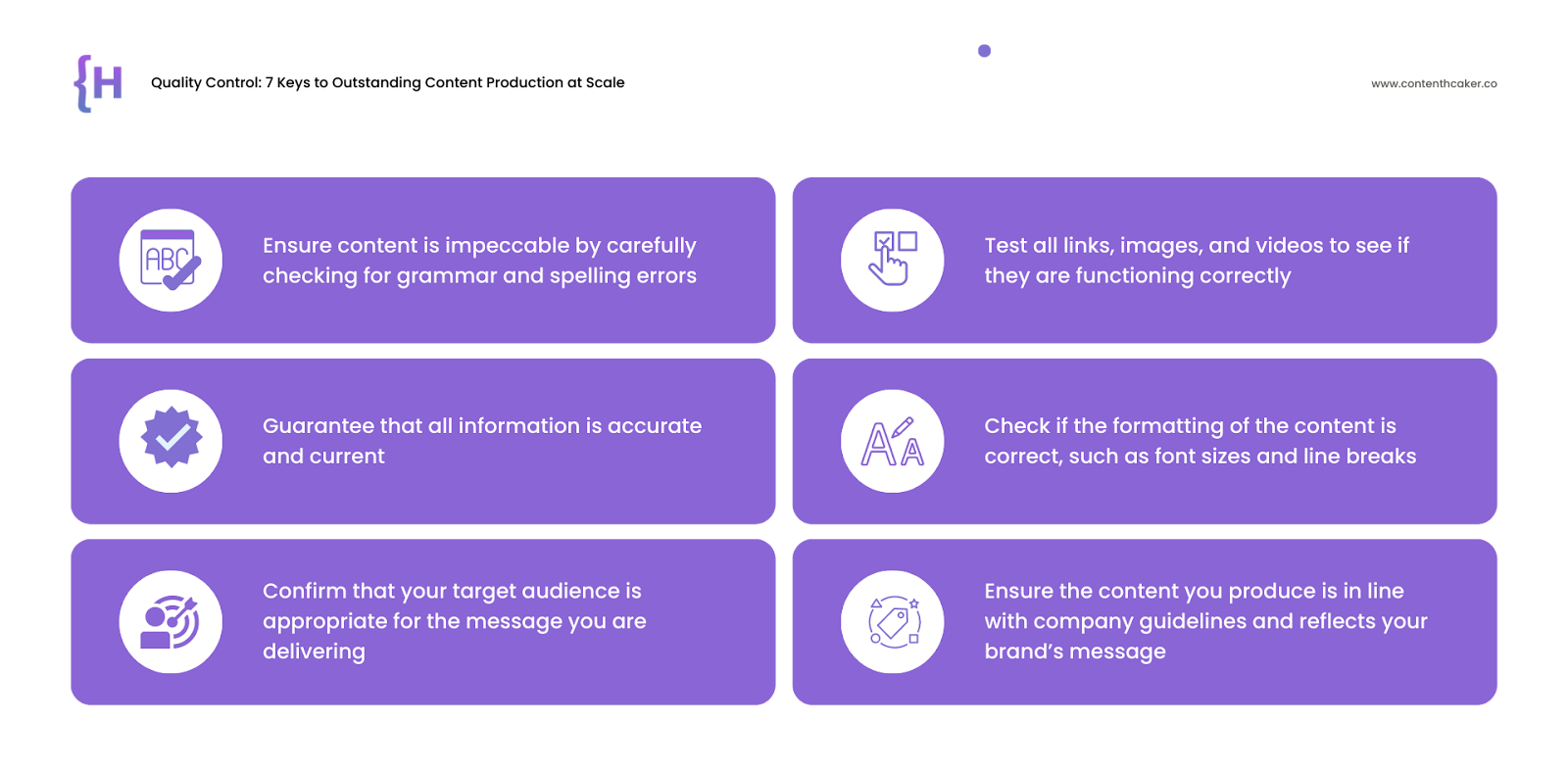
Image Source: Content Hacker
3. Communication Protocols
Set up dedicated communication channels for different project types. This keeps conversations organized and ensures nothing gets lost in lengthy email threads.
Establish regular check-in meetings and progress reporting schedules. Consistent communication prevents surprises and keeps everyone aligned on project status.
Create standardized project management workflows using tools like DashClicks’ project management software or similar platforms. These systems provide visibility into project progress and help identify potential bottlenecks before they cause delays.
Define emergency protocols for urgent revisions or deadline changes. Having clear procedures in place helps teams respond quickly to unexpected client needs. By standardizing review cycles, you minimize delays and keep clients confident in your process.
Technology Solutions for Content Coordination
The right technology stack can transform your content coordination from a manual nightmare into a smooth, automated process.
1. Content Management Systems
Choose CMS platforms that facilitate white label SEO collaboration. Look for systems that allow you to set up user permissions and access controls, ensuring providers can access what they need without compromising security.
Workflow automation features can streamline your review process by automatically routing content through approval stages. Integration capabilities with SEO tools and analytics platforms provide a complete picture of content performance.
2. Collaboration Tools and Platforms
Project management solutions designed for content coordination can significantly improve your workflow efficiency. Compare options based on your team size, project complexity, and budget requirements.
Evaluate communication platforms that support real-time collaboration. These tools help teams stay connected even when working across different time zones.
Assess file sharing and version control systems that keep everyone working with the most current versions. Review content approval workflows and digital signature solutions that speed up final approvals.
3. Performance Tracking and Analytics
Set up content performance dashboards that provide ongoing monitoring of your content's impact. Implement tracking systems that measure content delivery timelines and help identify areas for process improvement.
Create reporting mechanisms for provider performance evaluation. These reports help you make data-driven decisions about which partnerships to continue and expand.
Establish ROI measurement frameworks for white label SEO partnerships. Understanding the financial impact of your coordination efforts helps justify investments in better tools and processes.
Best Practices for Long-Term Success
Building sustainable white label SEO agency partnerships requires ongoing attention to relationship management and continuous improvement.
1. Provider Relationship Management
Develop comprehensive onboarding procedures for new white label SEO partners. A structured onboarding process sets clear expectations from the beginning and reduces confusion later.
Create performance evaluation criteria and regular review processes. These systems help maintain high standards and provide opportunities for feedback and improvement.
Establish contract terms that protect quality standards and timelines. Clear agreements prevent disputes and ensure everyone understands their obligations. Implement incentive structures for consistent high-performance delivery. Rewarding excellent work encourages providers to maintain their best efforts over time.

Image Source: Aprais
2. Scaling Content Operations
Design systems that can accommodate increased content volume without sacrificing quality. Scalable processes become essential as your agency grows and takes on more clients.
Create templates and standardized processes that maintain quality at scale. These tools help new team members get up to speed quickly and ensure consistency across all projects.
Develop training programs for internal team members who manage white label SEO relationships. Well-trained coordinators make the difference between smooth operations and constant firefighting.
Establish backup provider relationships to ensure continuity. Having reliable alternatives prevents project delays when your primary providers face unexpected challenges.
3. Continuous Improvement Strategies
Implement feedback collection systems from both clients and internal teams. Regular feedback helps identify problems before they become major issues. Create regular process audits and optimization cycles. Schedule time to review your workflows and identify opportunities for improvement.
Stay updated on industry SEO best practices and tool developments. The content marketing landscape evolves rapidly, and your processes need to keep pace. Monitor competitor strategies and adjust your coordination methods accordingly. Understanding what others are doing helps you maintain your competitive edge.
Common Pitfalls and How to Avoid Them
Even well-intentioned agencies make mistakes that can derail their white label SEO partnerships. Learning to recognize and avoid these pitfalls can save significant time and frustration.
Even with the best intentions, many agencies fall into predictable traps when coordinating content briefs and review cycles with a white label SEO partner. Recognizing these pitfalls—and knowing how to prevent them—can save hours of back-and-forth, protect client relationships, and keep campaigns moving smoothly.
1. Overloading Briefs With Unnecessary Detail
One of the most common mistakes is trying to cram every possible instruction into a content brief. While thoroughness matters, excessively long briefs often confuse writers, dilute focus, and lead to robotic content.
Solution: Keep briefs strategic, not encyclopedic. Focus on what matters most: target keywords, intent, structure, tone, and SEO must-haves. Attach supporting docs (like brand guides or keyword lists) separately so writers can reference them without cluttering the main brief.
2. Skipping Revision Protocols → “Surprise” Edits at the Last Stage
Agencies sometimes rush content straight to the client, bypassing a proper review cycle. The result? Last-minute “surprise” edits that frustrate providers, delay delivery, and undermine client trust.
Solution: Implement a Multi-Stage Review Process:
- Provider Quality Check – Ensure the draft meets baseline standards.
- Agency Review – Adjust for brand voice and campaign goals.
- Client Approval – Present polished content, minimizing revisions.
This structure sets clear expectations and prevents back-and-forth chaos at the eleventh hour.
3. Not Syncing Briefs With SEO Strategy Shifts
SEO is dynamic—Google updates, competitor moves, and campaign pivots all impact content priorities. A brief that isn’t updated to reflect these changes quickly becomes outdated, leading to wasted work.
Solution: Treat briefs as living documents. Revisit them quarterly (or when major SEO updates drop) to align with evolving strategies. A lightweight “brief update checklist” can help agencies ensure briefs always reflect the latest priorities.
4. Communication Breakdowns With Providers
Miscommunication is one of the biggest killers of content quality. Without clear channels and protocols, messages get lost, revisions pile up, and deadlines slip.
Solution: Use dedicated communication channels like DashClicks’ Live Chat Software instead of relying on scattered emails. Standardize feedback with templates and establish escalation protocols for urgent revisions.
5. Deadline Conflicts and Resource Constraints
When briefs or feedback arrive late, the entire content calendar gets derailed. Agencies often underestimate how much lead time providers need, especially for high-volume projects.
Solution: Build in buffer periods between review stages, and always communicate deadlines upfront. Consider maintaining backup providers or writers to absorb unexpected surges in workload.
Agency Tip: Don’t treat briefs as one-off documents. Make them “living playbooks” that evolve with your campaigns, client needs, and Google’s updates. This shift alone can cut revision cycles dramatically and strengthen long-term provider relationships.
Advanced Strategies for Agencies Scaling With White Label SEO Services
As your agency grows, your coordination strategies must evolve to handle the increased complexity and volume.
- Tiered Briefing Systems: Develop different brief templates for various content types. Blog posts require different specifications than landing pages or authority content pieces. Tailored briefs ensure each content type receives appropriate attention.
- Editorial Calendar Integration: Build your content briefs into a broader publishing roadmap. This integration helps ensure content supports overall marketing objectives and maintains consistent messaging across all channels.
- Feedback Loops and Performance Insights: Use provider performance data to refine future briefs. Track which specifications lead to the best results and adjust your templates accordingly.
- Quality Scoring Systems: Assign brief quality scores to track how well your instructions translate into successful content. This data helps identify which brief elements have the biggest impact on final quality.
DashClicks: Streamlining Content Coordination
Managing content briefs and review cycles becomes significantly easier with the right platform supporting your operations. DashClicks offers a comprehensive white label SEO services that addresses many of the coordination challenges agencies face when working with white label SEO partners.
The platform's project management tools allow agencies to create detailed content briefs, track progress through multiple review stages, and maintain clear communication with both internal teams and external providers. With built-in templates and standardized workflows, agencies can ensure consistency across all their content projects while reducing the time spent on administrative coordination.
DashClicks also provides performance tracking and analytics features that help agencies monitor the success of their white label partnerships. These insights enable data-driven decisions about provider relationships and process improvements, ultimately leading to better content quality and more efficient operations.
Future-Proofing Your Briefs & Review Cycles
The content landscape continues to evolve rapidly, and your coordination systems need to adapt accordingly.
- Adapting to AI-Generated Content: Incorporate guidelines for AI-generated content checks into your briefs. Specify how AI tools should be utilized and what level of human oversight is necessary to maintain quality standards.
- EEAT Signal Integration: Include Experience, Expertise, Authority, and Trust (EEAT) signals in your brief requirements. These factors play an increasingly important role in content performance and search rankings.
- Preparing for Search Evolution: Stay ahead of Google's evolving content guidelines, including changes related to zero-click searches and AI-generated summaries. Adapt your brief templates to address these emerging trends.
Agencies that systematize their coordination processes now will be more resilient and adaptable as the SEO landscape continues to change.
Transform Your Content Operations Today
Effective content coordination with white label SEO partners isn't just about avoiding problems—it's about unlocking your agency's growth potential. The systems and strategies outlined in this guide can help you increase content output, improve quality consistency, and strengthen client relationships.
Remember that implementing these changes doesn't have to happen all at once. Start with one or two key improvements, such as standardizing your brief templates or establishing clear review protocols. Build momentum with small wins before tackling larger systematic changes.
The ROI potential of proper coordination systems is significant. Agencies that invest in structured processes see dramatic improvements in efficiency, quality, and client satisfaction. These improvements translate directly into better profit margins and sustainable growth.
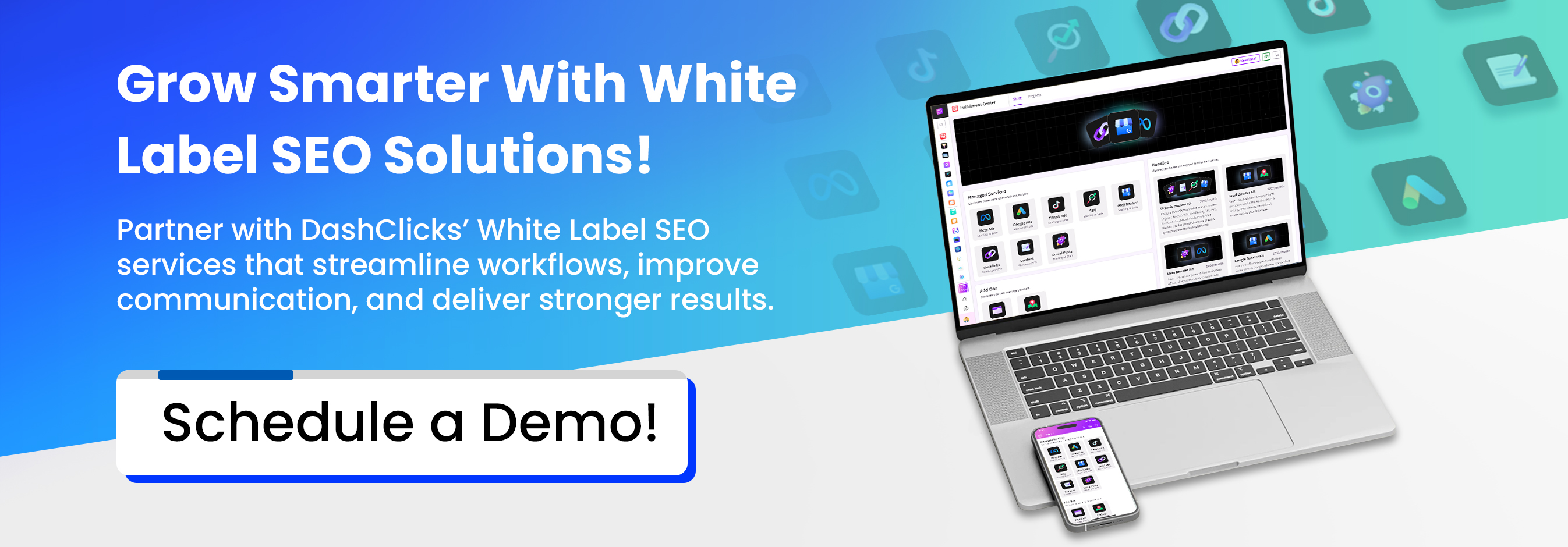

No results found.
Please try different keywords.
Get Started with
DashClicks Today
Get found online, convert leads faster, generate more revenue, and improve your reputation with our all-in-one platform.
.svg)
Unlimited Sub-Accounts
.svg)
Unlimited Users
.svg)
All Apps
.svg)
All Features
.svg)
White-Labeled
.svg)
Active Community
.svg)
Mobile App
.svg)
Live Support
.svg)
100+ Tutorials
.svg)
Unlimited Sub-Accounts
.svg)
Unlimited Users
.svg)
All Apps
.svg)
All Features
.svg)
White-Labeled
.svg)
Active Community
.svg)
Mobile App
.svg)
Live Support
.svg)
100+ Tutorials
.svg)
Unlimited Sub-Accounts
.svg)
Unlimited Users
.svg)
All Apps
.svg)
All Features
.svg)
White-Labeled
.svg)
Active Community
.svg)
Mobile App
.svg)
Live Support
.svg)
100+ Tutorials



.svg)
.svg)
.svg)
.svg)
.svg)


